#polygon has such a track record of this for no reason
Explore tagged Tumblr posts
Text
Ok but seriously what is Polygon’s problem with CR.
#that DH article somehow managed to praise Spenser Starke as the greatest ttrpg designer of our time#while decrying his latest design demo simply due to its affiliation with Darrington Press#polygon has such a track record of this for no reason#like it’s *bizarre* at this point
51 notes
·
View notes
Text
A few more random Stan and Ford thoughts that build off of previous posts I've made in the last few days. It's fun speculating and delving into the sub-subtext of their actions and relationship. (And then it's time to WRITE).
"Thank You"
So I mentioned the tags of this post that I feel Stan's preoccupation with getting his brother to say "thank you" goes far beyond just acknowledging the thirty-year sacrifice Stan made to bring Ford back. As mentioned, Stan has a tendency to imagine himself in heroic circumstances, in situations where he is thanked by grateful family and community members, where he is acknowledged and through those two words, is told that he has value and is loved (even if his imagined methods of getting those two words out of people feels somewhat transactional - unsurprising given the way Filbrick treated him in his youth).
Anyway, Stan holds up the entire zodiac just to hear Ford say the words "thank you," even if they were forced. We know Stan is feeling once again that Ford will be vaunted as the hero and Stan pushed aside as a nobody should the zodiac succeed (despite the blame for Weirdmageddon falling partially on Ford to begin with).
But I think there's another layer here.

Stan's not 100% convinced the zodiac is going to work. He knows his brother is a genius but Ford's track record with these things isn't exactly pristine, even if his persona would present as otherwise. If we take the idea that "thank you" is really a way of saying "I love and value you," in Stan's mind, and if we assume Stan halfway believes they're all about to die, the zodiac notwithstanding...
It may be that - subconsciously or not - that Stan is holding up the ritual to hear his brother say "thank you" (translation: "I love you") for the first (and what may be the last) time in forty years. And yes, maybe it's about Ford getting all the credit and being the hero, but Stan just might want to hear his brother utter those words of affection - however forced - just once before they all horribly at the hands of a a three-sided, polygonal demon. In essence, Stan's dying wish is to hear his brother say "I love you." (And this makes the scene post-memory gun all the more painful, Ford gathering his brother in his arms, calling him a hero in the way Stan would have always wanted to hear, that coded language for "I love you" that a memory-wiped Stan would have no way of understanding).
Breaking the Portal
In another post the other day, I talked about the audacity of Ford worrying that Stan may break the Portal if he comes to Gravity Falls, the very thing that Ford should have done from the outset after learning of Bill's true nature.
It's interesting that in the same paragraph, Ford writes in the "Bros Code" he and Stan had devised during their childhood, wondering if he has been too harsh all these years.

We know Ford is basically incapable of destroying his own research, despite the fact it could spell the demise of his entire dimension. Hell, the entire time we know Ford through the show and the books, he never once plays a part in destroying his own work. (Stan ends up rendering the Portal unusable when he brings Ford back and Ford chucks his journals into the Bottomless Pit post-series, meaning they'll disappear (he thinks) in his realm but they'll still exist).
Again, speculating on subconscious motivations here (paging Dr. Freud), but you have to wonder if part of the reason Ford wants Stan to come to Gravity Falls (aside from the fact he sorely needs another person he can trust) is that he almost hopes Stan will be the bumbling fool Ford's made him out to be and do something that may partially or fully sabotage the Portal. He obviously has conflicting emotions when it comes to his brother, but Stan would also be the perfect scapegoat if he did accidentally do something to interfere with the Portal. For Ford, it's a win-win, in that he would not have to force himself to take action against his life's work (and therefore render himself utterly useless after how many years of research) and he would have an excuse to keep his grudge going against his brother, to keep up that facade of anger and dismissiveness that allows Ford to categorize Stan as "lesser," as the source of Ford's problems and an incurable fuck-up who only gets in Ford's way. (All this while having his brother physically present, a comfort I have no doubt Ford is desperate for at this point).
This is not Ford's primary or secondary (or tertiary, even) motivation in calling Stan to Oregon, nor is it the major reason Ford refuses to destroy the Portal and his Journals. The whole thing is a Hail Mary pass, to be certain, as Ford had no way of knowing his brother would receive the postcard and show up on his front doorstep. (And what was Ford's backup plan at this point? What if Stan hadn't come? Or he was delayed? We know Ford's not operating on all cylinders at this juncture, but holy hell, dude, just shut down the damn Portal.)
This all being said, it wouldn't shock me if somewhere in the dark recesses of Ford's mind, he's working out this rationalization, which is something we know Ford is very, very good at. ("For science!" he'll claim, as if those words were an incantation that absolve the actor of any negative responsibility, like desecrating a corpse for a brain, yeesh, Ford).
Anyway, food for thought (and writing).
#hello there#stanley pines#stanford pines#these two#in alex's words#they are so DAMAGED#emotionally#ugh why is this show such a tragedy??????
15 notes
·
View notes
Text
Ranking the Flowey "Specimen" Fights

First of all, let me just say that I have no explanation of where these ideas came from or why the tracks for each phase of the Flowey fight are called "specimen." I know the whole thing is meant to parallel the SOULs in UT OG, but where did Flowey get some of these ideas? As for the term "specimen," I've seen the theory that Alphys was injecting various materials with DT, and Flowey was imagining if they had come to life like he did. Makes as much sense as anything I could have come up with.
Ratings are on a scale of 1-6. Fights are listed in no particular order. And for the record, I already know my opinions differ from those of the larger population.
Paper
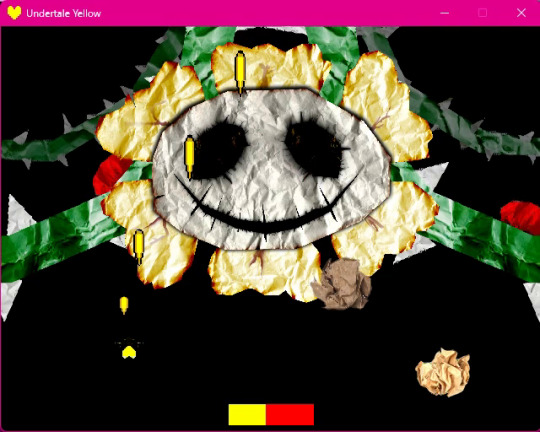
Not super-creepy, not tough to fight, not a lot of lore, and the music's actually kinda chill. I feel like the music only feels so creepy because of the context. Really, the scariest thing in this fight is... that face....
Music: 4 Battle difficulty: 2 Creepiness: 2 Lore implications: 2
Clay
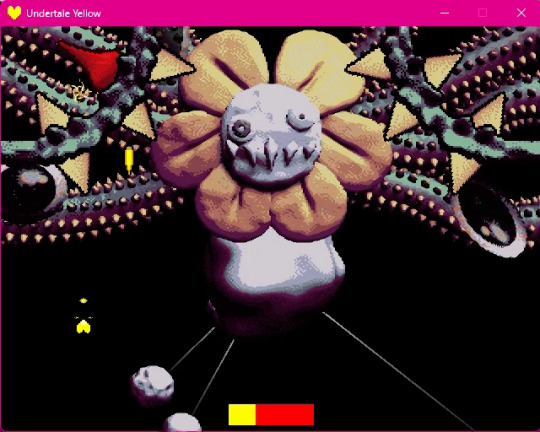
Call my crazy, but I swear I see Prunsel and hear Jevil in this one. Otherwise, it's just weird and a little difficult.
Music: 2 Battle difficulty: 5 Creepiness: 4 Lore implications: 3
Polygonal
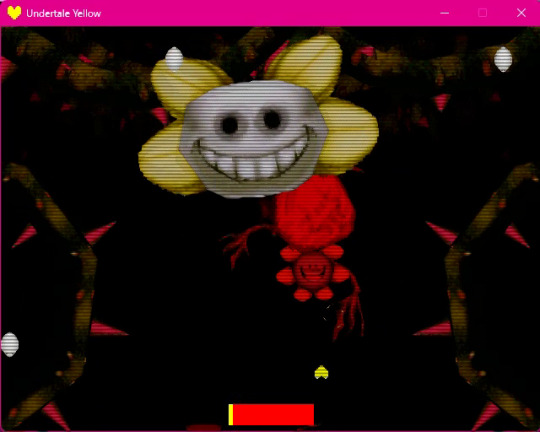
HANDS. DOWN. THE. WORST. One Flowey face is bad enough, but him summoning multiple versions of himself? Which are blood red and always swipe at you at the worst possible moment? I LOATHE this one. Plus, it's the UT-verse version of "scary beyond all reason." Even more than any Fell that I've seen. The music is probably the least scary thing about this fight, and even that gives me BOTW blood moon vibes.
Also, gotta wonder why Alphys would have labelled this one "polygonal." The heck was she experimenting on? A snowdecahedron?
Music: 3 Battle difficulty: 6 Creepiness: 6 Lore Implications: 1 (it's just all Flowey)
Patchworked
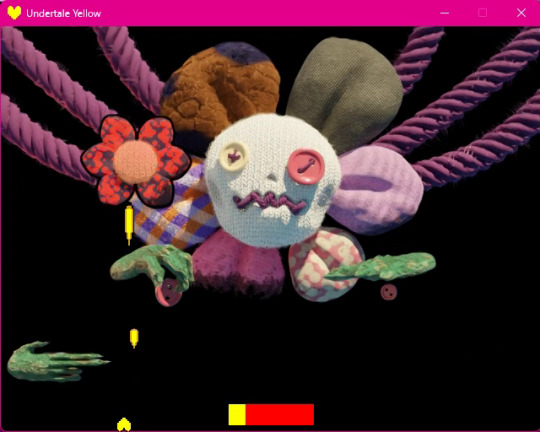
Did Flowey watch Coraline or something??? And the music- it's like a mashup of Your Best Friend and The Circus.
The most intriguing thing is the use of the finger guns, which, of course, we can recognize from Omega Flowey's fight. The question then becomes: did Flowey get the finger gun idea FROM Clover and Star? Especially since he shoots nails, which... I get the pun, "finger" + "nail," but nails also have the highest attack of any ammo other than friendliness pellets.
Music: 1 Battle difficulty: 4 Creepiness: 3 Lore implications: 5
Mechanical
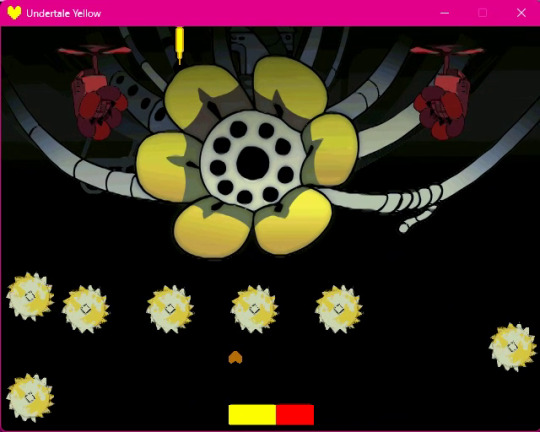
Dude, check it out, the Floweynator.
A little difficult, not too bad. Not really too creepy, unless you stare too hard at Machine Gun Flowey's face. It is interesting to think that Alphys was experimenting on machinery with DT. Because, you know, she built Mettaton by sticking a SOUL in a robot.
Also, I've seen the theory that Flowey learned about nuclear bombs and things like that from Chara, so he probably learned about machine guns and hovering drones and things from Chara, too.
Music: 5 Battle difficulty: 3 Creepiness: 1 Lore implications: 4
Organic
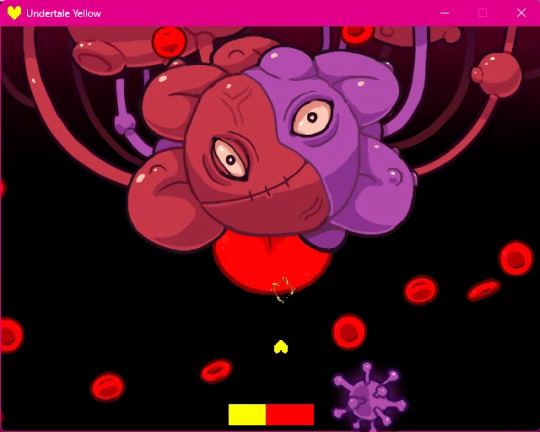
I think this is my favorite, actually. Yeah. I'm being totally unironic.
Honestly, it's just creepy. First of all, how does Flowey, a monster who has presumably never seen the surface, know so much about blood? Possibly from Chara, but I have trouble believing that a kid could have told him that much about how the human body works (then again, we are talking about Chara...). Not to mention Flowey getting the heart monitor sound right, that would be very difficult from just a description.
The most obvious solution (to me, anyway) is that Alphys was using an organic lifeform for testing. Since she said she wanted to test a subject that didn't have a SOUL, and we know from Dina that there are non-sentient animals in the Underground that are either kept as pets or used for food, the most likely answer is that Alphys was using a snake or bird or something.
But consider...
What if Alphys was using a human body, or at least samples from a human body, as the "organic" subject??? Technically, the human wouldn't have a SOUL anymore, because their SOUL is already in a glass case behind Asgore's throne room.
Music: 6 (I know most people think it's boring, but I think the heart monitor just adds to the creepiness) Battle difficulty: 1 (not difficult at all to dodge) Creepiness: 5 Lore implications: 6
#undertale yellow#flowey#neutral run#final boss#my opinion#ranking#my screencaps#theory#my theory#my headcanon
7 notes
·
View notes
Text
Bitcoin Breaks Records: What It Means for Crypto in 2025

Bitcoin’s price has reached an all-time high again in 2025, breaking its previous January record and making headlines across global financial platforms. Surpassing expectations, this surge signals more than just market excitement. It reflects deeper shifts in investor confidence, regulatory dynamics, and the evolving maturity of the cryptocurrency ecosystem.
As we move through the year, the impact of Bitcoin’s rapid rise is being felt far beyond just the trading community. From policymakers to retail investors, everyone is watching closely. This post dives into the key drivers behind this surge, what it means for the broader crypto space, and how players like Qwegle see the road ahead.
What’s Driving the Bitcoin Price Surge in 2025?
The most immediate factor behind Bitcoin’s current momentum is a combination of institutional confidence, ETF approvals, and improving regulatory clarity, particularly in the United States.
Earlier this month, several major financial firms received approval for spot Bitcoin ETFs, enabling broader investor participation without direct coin ownership. This has brought in billions in new liquidity, elevating market optimism. According to CNBC, the sharp price increase has coincided with the highest monthly inflows ever recorded into crypto-based financial products.
At the same time, new legislation under review in the U.S. aims to offer a unified legal framework for digital assets, minimizing previous gray areas. This policy clarity has not only improved sentiment but also allowed risk-averse investors to re-enter the space with greater confidence.
Livemint’s recent report also suggests that improved macroeconomic conditions, including lower inflation expectations and stabilized interest rates, are pushing more capital into alternative assets like Bitcoin.
Market Sentiment Is Shifting
Retail investors, along the backbone of Bitcoin’s narrative, are returning in large numbers. Platforms like Coinbase, Binance, and Robinhood have reported record signups in the past two weeks alone.
Meanwhile, tech entrepreneurs and fintech startups are finding renewed motivation to launch blockchain-based services, wallets, and dApps. Bitcoin’s resurgence is also impacting other digital assets, bringing fresh attention to Ethereum, Solana, and Avalanche.
As NDTV notes, this current rally is marked not just by price action, but by real traction in user activity and application development.
Bitcoin’s Influence on the Broader Crypto Ecosystem

When Bitcoin performs well, it often lifts the entire digital asset landscape. The current upswing is no different. Ethereum has seen a sharp rise in trading volumes, partly thanks to its utility in DeFi and NFTs. Other tokens, such as Polygon and Chainlink have also gained, fueled by growing demand for decentralized finance platforms.
Developers are using this momentum to test new Layer 2 solutions, experiment with zero-knowledge proofs, and bring scalability to the forefront. Innovations like these may not generate as many headlines as Bitcoin’s price, but they are equally crucial in pushing blockchain toward real-world utility.
What the Surge Means for Investors
For crypto investors, this surge presents both opportunity and caution. On one hand, there is real enthusiasm backed by solid institutional support. On the other hand, the Bitcoin price surge in 2025 reminds everyone that crypto remains a volatile asset class.
Newcomers should be wary of entering purely out of fear of missing out. Understanding technical indicators, market cycles, and news flow is critical. Moreover, investors should evaluate how much of their portfolio can reasonably be exposed to high-risk assets.
Education is key. Tools that offer real-time analysis, sentiment tracking, and safe custodial solutions are more accessible than ever. Investors who equip themselves with the right knowledge are better positioned to make informed decisions rather than react emotionally.
Key Challenges That Remain
Despite the optimism, several challenges must be addressed. Bitcoin’s energy consumption remains a topic of debate, especially as environmental concerns gain global attention. While miners continue shifting to renewable sources, scrutiny over sustainability continues to hover.
Additionally, questions around interoperability, cross-border regulations, and security still linger. Phishing scams, wallet breaches, and DeFi exploits remind us that despite technical advancements, safety must remain a priority.
Volatility also continues to be an issue. What goes up rapidly in the crypto world can just as quickly drop. Therefore, stakeholders need to balance excitement with risk management.
Qwegle’s Perspective on Crypto Growth
At Qwegle, we have long recognized the disruptive power of blockchain and digital assets. Our work with startups, fintech firms, and enterprise teams has focused on delivering value through practical, real-world innovation.
When advising clients on digital transformation, we emphasize that crypto must be approached strategically. Whether it's payment processing or token-based ecosystems, adoption must be aligned with tangible goals.
The current Bitcoin price surge in 2025 has created a new wave of curiosity. At Qwegle, we help businesses make sense of this momentum, ensuring they explore blockchain adoption with a strong foundation. We believe that digital currency is a transformational shift in how people and businesses interact online.
What Lies Ahead

The future of Bitcoin and cryptocurrency is not guaranteed to be smooth. However, the developments unfolding now show that this space is moving beyond its speculative origins. With real institutional backing, growing retail interest, and rising developer engagement, crypto is evolving into a mature segment of the financial system.
Whether Bitcoin will maintain its current highs or face another correction remains to be seen. What is clear, however, is that digital assets are here to stay. For traders, builders, and businesses alike, understanding the forces at play is essential for success.
In the coming months, expect more clarity on regulation, more product launches around Bitcoin ETFs, and a growing number of traditional banks entering the space. This blend of old finance and innovation will define crypto’s next chapter.
Final Thoughts
The Bitcoin price surge in 2025 is more than just numbers. It is a reflection of growing trust, better infrastructure, and changing global finance dynamics. It is also a wake-up call for anyone still on the sidelines to start adapting to the ecosystem.
As Qwegle continues to collaborate with innovators across fintech and enterprise, we see this moment as a critical inflection point. The future of money is being written now = and Bitcoin is at the center of that story.
0 notes
Text
Smart Contracts and the Rise of Blockchain Development
Blockchain has changed how businesses build and trust digital systems.
At the core of this shift is the rise of smart contracts.
These are not just tools. They are the backbone of many blockchain platforms today. They help run apps, process rules, and automate workflows without needing manual steps.
As more industries go digital, smart contracts are becoming central to new services and business models. This has pushed the growth of blockchain systems designed to support real-world use.
The connection between smart contracts and blockchain development is strong. One drives the other forward. Together, they’re shaping how the future of digital systems will work.
What Smart Contracts Really Do
A smart contract is a piece of code that runs on a blockchain. It holds rules and executes them when conditions are met.
Unlike traditional contracts, smart contracts are automated. They don’t need approval from a person once launched. They don’t rely on a central authority.
They sit on the blockchain, which means no one can change them once deployed.
For example, if two people agree on a payment when a product is delivered, the smart contract holds the money and only releases it when delivery is confirmed.
This removes the need for a middleman.
The rise in use cases is fast. Payments, insurance, loans, licensing, and voting—smart contracts can power all of them.
This demand is why every Blockchain Development Company now focuses heavily on smart contract development as part of its services.
Why Businesses Are Shifting to Smart Contracts
Traditional systems take time and involve too many steps.
A loan might take days to approve. A trade settlement could take weeks.
Smart contracts reduce that to minutes.
They remove delay and reduce human error. They also improve transparency.
Every action taken by a smart contract is recorded. Everyone can see what happened and when. This makes tracking easier and builds trust between parties.
Businesses use smart contracts to lower costs and speed up their processes.
They also help prevent fraud. Because the contract’s code is public and secure on the blockchain, no one can tamper with it after deployment.
This is a major reason why companies are turning to blockchain solutions.
They are looking for a Blockchain Development Company that can create smart contracts tailored to their needs. They want tools that are reliable, secure, and easy to use.
Popular Platforms for Smart Contract Development
Ethereum was the first platform to introduce smart contracts widely.
It still leads the space. But others have joined.
Platforms like Solana, Polygon, Avalanche, and Hyperledger are also used for smart contract deployment.
Each platform has its strengths. Some offer faster transactions. Some focus on private chains for enterprises. Others reduce energy use.
The choice depends on the use case.
A business might use Ethereum for public apps. It might choose Hyperledger for private deals between trusted parties.
Blockchain Development Companies in India have gained deep experience across these platforms. They guide businesses in picking the right one. They understand what works best for finance, retail, supply chains, or legal workflows.
This platform diversity gives businesses more control over how they adopt smart contracts.
How Smart Contracts Automate Digital Processes
Think of a supply chain. A product moves from a factory to a store.
A smart contract can be set up to pay suppliers at each stage.
As soon as the factory marks the item shipped, payment is released. When it reaches the distributor, another payment is made.
This all happens without human input.
Every stage is tracked and verified on the blockchain.
This reduces errors. It also ensures that everyone gets paid on time.
Smart contracts can also handle subscriptions. They can run royalty payments. They can control who has access to digital products.
They are flexible tools. Once written correctly, they follow rules without missing steps.
Blockchain Development Companies in India build such contracts with care. They test them in various scenarios. They also make sure they meet the required laws and compliance rules.
Smart Contracts in DeFi and Finance
Finance has seen some of the biggest smart contract use.
Smart contracts power lending, borrowing, staking, and yield farming.
They allow users to deposit money and earn interest without using a bank. They allow people to trade assets instantly.
These platforms work 24/7. They don’t need branches or support teams.
Smart contracts make the whole system possible. They hold funds. They calculate interest. They apply penalties. All based on code.
In this sector, bugs and security issues can cause losses. That’s why skilled developers are critical.
A strong Blockchain Development Company will run tests and audits. They will write safe code. They’ll make sure that money is handled properly by the contract logic.
Growth in Demand for Custom Smart Contracts
Off-the-shelf tools don’t always work for all businesses.
As blockchain adoption increases, companies want smart contracts built for their unique workflows.
They don’t want generic systems. They want contracts that handle their data, fit their process, and talk to their systems.
This demand for custom smart contracts is growing fast.
From real estate to logistics, from gaming to digital rights—everyone wants automation that matches their rules.
This is where Blockchain Development Companies in India are seeing more projects.
They’re creating contracts for token sales, loyalty points, supply chains, and more. Each one is designed from scratch, based on how the business works.
Challenges in Smart Contract Development
Smart contracts can’t be updated easily after launch.
This means mistakes in the code can be expensive. Bugs can lock funds or let attackers in.
Developers must write the logic correctly the first time. They must test the contract in every possible way.
This is not easy.
There’s also the issue of cost. Some platforms charge fees to deploy contracts. If the code is not optimized, costs go up.
Scalability is another challenge. As more people use a smart contract, it must be able to handle the traffic.
A Blockchain Development Company has to plan for these challenges. It must think ahead. It must use clean code, thorough testing, and secure methods.
Some companies also use upgradeable contracts. These can be changed later without starting over.
It takes experience to design such systems. This is why businesses choose experienced developers for the job.
Security and Smart Contract Audits
Security is a major concern in smart contract work.
Even one small bug can cause losses. Smart contracts control money. That makes them a target.
To prevent attacks, developers must audit the code.
They check every line. They test every path. They use tools to find hidden issues.
This is called a smart contract audit.
It’s not just a step. It’s a must.
Many Blockchain Development Companies in India offer auditing services. They check contracts before launch. They help fix problems. They also give reports on what was tested.
This builds confidence in the system.
A smart contract is only as good as its security. That’s why audits have become a key part of the development cycle.
The Role of Blockchain Developers in the Smart Contract Ecosystem
Smart contracts don’t work alone. They must talk to wallets, web apps, databases, and users.
Blockchain developers are the ones who build this bridge.
They write the contract. They build the app that interacts with it. They create dashboards, wallets, and triggers.
They also handle testing, deployment, and upgrades.
A Blockchain Development Company provides all these services in one place.
It brings together frontend developers, backend engineers, smart contract coders, and testers.
Together, they create a full solution—not just a piece of code.
The Road Ahead: Smart Contracts in Mainstream Use
Smart contracts are moving out of labs and into real life.
Governments are testing digital land records.
Banks are exploring tokenized bonds and automated settlements.
Retailers are building customer rewards on smart contracts.
This is not a trend. It’s the next step in digital transformation.
Smart contracts offer businesses speed, savings, and trust.
As their use grows, so does the need for skilled development.
Blockchain Development Companies in India are now at the center of this change. They help global businesses plan, code, and run smart contract systems.
They understand both the tech and the business side. They deliver full-cycle support. That makes them a key part of the blockchain rise.
Conclusion
Smart contracts are changing how we think about automation and trust.
They run business logic without delay or error. They connect parties without middlemen. They help build systems that are lean and reliable.
Their rise has powered the growth of blockchain as a full platform for business tools.
To make the most of smart contracts, companies need expert development. They need a Blockchain Development Company that can turn business rules into working code.
This is where Blockchain Development Companies in India have stepped up. They offer the right skills, the right tools, and the ability to deliver results.
Smart contracts are not just lines of code. They are digital agreements that work, scale, and shape the future.
And that future is already here.

0 notes
Text
A Break for BlizzCon (and the possible future of in person events)
Blizzard has announced that BlizzCon is taking a break for 2024.
BlizzCon is Blizzard’s annual gaming event. The one to two day event is full of events, game announcements, cosplay, and big concerts headlined by popular musicians. The event draws big crowds, averaging 25,000 over the past decade, and has been a cultural staple for the past decade for gamers.
Blizzard’s reasoning for not holding an event is that they want to focus on smaller, more intimate events focusing on specific games. Despite not holding BlizzCon, Blizzard will be attending trade shows such as Gamescom.
This year has been a wild one for Blizzard, from its record Microsoft acquisition to its subsequent layoff’s of almost 2,000 people across Microsoft’s gaming division.
This also is not the first time Blizzard has canceled BlizzCon. Notably, 2022’s BlizzCon was canceled after state federal workplace harassment lawsuits were brought into the media. BlizzCon was also canceled in 2020 due to the pandemic.
The cancellation of BlizzCon 2024 calls into question the popularity and relevance of big gaming events. Notably, E3 has retired and is “100% dead” as Polygon puts it. Similar to BlizzCon, following the Pandemic, it's been hard to see events focusing on large gatherings thrive again.
With this cancellation, it's noted that Blizzard is going to have to fight harder to show off their new projects. Despite everything being announced in one big event, people would need to seek out the individual events - which can be difficult as it can lead to people only focusing on the projects they care about and not focusing on anything else.
With Blizzards previous track record of canceling BlizzCon events, the impacts of the pandemic, and the general way that the gaming industry is going, its a wonder if Blizzard will host another event. Even major events such as The Game Awards have faced empty seats recently at their most recent event. The way of the future does not look like it’ll be one with big gaming conventions. What it will be, that's for us to find out.
Word Count - 344
0 notes
Text
Explore About TRC20 Token Development In Detail
TRC20 is a token standard on the Tron blockchain ecosystem. TRC-20 is also the technical standard adopted for smart contracts on the TRON blockchain. TRC20 tokens carry features and functions that enhance compatibility with the ERC20 token standards on the Ethereum blockchain. There are different token development standards on the Tron blockchain, including TRC10 and TRC721. Today, TRC20 token development finds regular adaptation and usage for the key benefits and advantages it gives to the users on the blockchain.
But what is it, and what are its features and functions? How are the TRC20 tokens created and developed? What are the benefits of developing these tokens on the blockchain? We learn all of this and more in this blog.
Features and functions of the TRC20 tokens.
Integrated smart contracts
High scalability
Optimized gas fees
High availability
Seamless and easy integration
Fast transaction speeds
Integrated advanced security features
Interoperability and compatibility
How to create TRC20 tokens
Create a smart contract address.
Decide the unique token symbol, name, decimal value, and total supply of your token.
Create a token wallet.
Make sure that all the credentials incorporated are correct.
Connect your token wallet with Tronscan to execute TRC contracts.
Deploy your TRC20 token.
With a specialised a cryptocurrency token development company like Coin Developer India, there are also custom services that establish the purpose of creating the tokens. This process follows a personalised touch with these steps.
Business consultation and requirements gathering
Token creation
Whitepaper writing
Cryptocurrency wallet development
Token testing, launch, and deployment
Listing on the cryptocurrency exchange.
Benefits of TRC20 token development on the blockchain.
TRC-20 allows the creation of tokenized assets that can be traded on the TRON network.
TRC-20 is highly compatible with Ethereum's ERC20 token standard.
TRC-20 has a high degree of transparency.
It is cost-effective and affordable to create and develop TRC20 tokens.
TRC20 tokens facilitate faster transactions on the blockchain.
TRC20 tokens are easily swappable with other tokens on the blockchain.
There are several blockchain transactions that can be executed using TRC20 tokens.
TRC20 payments are processed on peer-to-peer decentralized networks.
TRC20 transactions are easily tracked and recorded on the Tron blockchain.
With TRC20 tokens, investors enjoy lower transaction fees and quicker settlement times compared to other cryptocurrencies.
TRC20 smart contracts enable decentralized transactions for users.
Decentralization enhances trust and transparency in blockchain transactions with TRC20 tokens.
Secure peer-to-peer payment ecosystem with TRC20 tokens.
The Tron blockchain offers higher scalability potential, with more than 2000 transactions per second.
Why hiring Tron developers from Coin Developer India is a worthwhile decision.
Coin Developer India is an experienced and professional token development service provider with years of experience in the blockchain industry.
Clients also get the best subject matter experts on Tron blockchain development.
You get access to diverse customization options with your Tron token development project.
It is cost-effective and affordable to develop Tron blockchain development solutions.
Post-launch and deployment technical support for a specified time to handle any challenges and also enable clients to attract more crypto traders on their Tron blockchain.
Conclusion
There are multiple token standards across various platforms on the blockchain networks, like Tron, Ethereum, Binance Smart Chain, Solana, Polygon, and others. TRC20 is one of the leading blockchains for a variety of reasons, some of which are seen above. TRC20 token development gives token developers great ways to create custom tokens and digital assets on the Tron blockchain. It creates a great atmosphere for innovative and creative token development services. Coin Developer India is a top-ranked token development company with a versatile grasp of the Tron token standards and other blockchain solutions. You can create your business' TRC20 tokens by integrating great features with the best Tron development experts today.
Quick connect for any requirement. Call/Whatsapp: +91 7014607737
0 notes
Text
How much would it cost to build a gaming pc 2015
Tips For Starting A Gaming Blog
We've once again teamed up with our good friends at Dire Wolf Digital Studios to bring this remarkable game to your gaming table. Hi Frags, it all comes down to the excellent of visitors you get. Promoting stuff via your site is tough when there are only general content on it, but if you target a precise group of gamers and make a loyal following, recommending products gets a lot easier. It will also depend on the sort of items you sell, there are eventually a lot of aspects contributing to getting a prosperous gaming weblog. Truly glad you liked the write-up! I will absolutely check out your blog.
Genuinely glad that my blog inspired you to start your own. Yes it is really hard work and it requires some time to develop, but if you do it properly you can have a terrific on-line brand. Starting the weblog is only the beginning, so make confident to study the rest of my articles in the Gaming Blog Series which will take you by way of all the steps. If you have any inquiries do not hesitate to ask me, I'm delighted to enable exactly where I can.
With the abundance of established gaming sites present on the web, it is best to do some competitor analysis and research about the most preferred web sites and the newest trends in gaming to preserve your site up to date. A few search queries on Google would aid you see what are the most up-to-date trending subjects gamers are seeking at. This will support you see what most gaming sites have to supply, and how they present their content to their audience. You would also be in a position to locate out how to stand out and know your audience superior.
I got into action games late but when I did it entirely changed how I viewed gaming forever. The game which brought me round was Viewtiful Joe. Here was a game with a deep and open-ended combat technique which seemed to be built as a signifies for the player to express creativity. This method is then pitted against opponents and obstacles which had been made from the ground up to interact meaningfully with the core program. The course was fixed, but the system for dealing with that course was entirely down to the ingenuity, skill and inspiration of the player. You play like you have a large audience watching and the game continually entices you to enhance the concentrate is not just on obtaining the player from A to B, the concentrate is on obtaining the player to play Viewtifully”.
People are gaming on tablets, smartphones, smartwatches, consoles and quite a few other devices. This is the suitable time to take a plunge into the gaming market. If you are not a game developer it doesn't mean you cannot make some profit from it. Overall, developers are hunting into extra strategies on how to market their games and this is where you can turn into the next massive player.
Don't you want you have been definitely sitting on a racecar seat every time you play Forza, Gran Turismo, or any other racing game? With the racing seat design and style of the Ficmax Swivel Gaming Chair , obtaining this expertise is now a reality. The completely ergonomic Ficmax is designed with a completely retractable footrest to enable sooth tired reduce limbs and aid facilitate the much more efficient circulation of blood. It also comes with a lumbar massage assistance to assist avert or even handle low back discomfort which is very common amongst people who sit in an workplace chair for unusually lengthy period. Our handy guide to the finest ergonomic workplace chairs capabilities a lot more terrific products like this.
Take 10 Minutes to Get Edge With MATCHING
Paul: Our organization model is development focused and we cover three important regions in the gaming sector. Firstly, we're a international e-Commerce retailer promoting over 7,500 games from 450 publishers in over 190 countries to millions of gamers. Secondly, Green Man Gaming has a thriving neighborhood who talk about and track their game achievements on our neighborhood platform. This data combined with the industrial information of the retailer offers Green Man Gaming a considerable depth of know-how of our shoppers. Finally, we have a publishing arm that assists developers publish their own games and bring them to market, supporting them every step of the way. The fusion of Green Man Gaming's e-Commerce shop, a strong community producing billions of information points and publisher assistance sets us apart from our competitors.
Today's games are larger, superior, and additional immersive than ever. You can discover remarkable games across a wide variety of genres. Most big game franchises are out there on both PlayStation 4 and Xbox One, though the Nintendo Switch delivers a substantial selection of games suited for kids and families. For the most realistic visual experiences, upgrade to the PlayStation 4 Pro or Xbox One particular S to love breathtaking 4K and HDR gaming. Exclusive titles are obtainable for every single console, which additional underscores the need to have to strategy ahead and pick up the appropriate technique for your ought to-own games. Explore the massive collections of previously played games at fantastic offers and give your older consoles like the PlayStation three , Xbox 360 , and Nintendo Wii U continued life.
Nintendo 64 and PlayStation ushered in a new era of gaming. Polygons replaced pixels, and 3D rendering entered into the gaming vocabulary. Retro gaming hits like Crash Bandicoot, Mario Kart 64, and 007: Goldeneye pushed the limits of technology, and made the most realistic virtual environments observed up to that point. We also have some retro games for systems that could possibly not really feel as old as they are, such as PlayStation two, Nintendo GameCube, and the original Xbox.
Gaming content remains one of greatest methods to attain young guys. Tubular Labs reports that amongst millennial males, gaming— specifically, gameplay— ranks in the prime 3 categories for each 18—24-year-olds (#1) and 25—34-year-olds (#2). But what about ladies? As it turns out, adult women have not too long ago unseated teenage boys as the biggest video game— playing demographic, according to the Entertainment Application Association YouTube trends reflect this: Viewership among women has doubled year over year, and women over the age of 25 are the quickest-developing demographic for gaming content material.
So, to assist you monitor and fix these concerns, we've selected some amazing WordPress Gaming themes we can personally propose. They are highly accommodating to a wide range of purposes for your web sites. For your convenience, we've highlighted all their core capabilities, areas of usages and essential elements for these great gaming themes. Moreover, the list also consists of superb absolutely free WordPress gaming themes so you can begin your gaming website with minimal fees. So with no additional ado, let's take a look at our list of each premium WordPress Gaming Themes and no cost Gaming WordPress themes.
Ask your self why you're considering starting a gaming weblog or youtube channel? If it is for the reason that you believe you have what it requires to be the subsequent PewDiePie or DanTDM (or TheTechieGuy ), then you are not alone. Nevertheless, your primary reason ought to be that you have an overwhelming enjoy for gaming. It does not hurt to have a terrific voice and something to contribute to the gaming network. (Of course, the perks ain't poor when they get started rolling in, either).
Previously, N'Gai Croal wrote articles for Newsweek, Croal left Newsweek back in March due to the fact he wanted to follow his passions slanted more towards the development finish of gaming. Croal describes himself as a inventive maverick that identified himself sidetracked in journalism, but this short-term exploration became one particular of the most remarkable things that Croal has ever carried out. As a journalist, Croal has enriched his own point of view and improved his understanding by way of journalism for the reason that he has written about a assortment of subjects.
Nonetheless, there is no need to have to do an internet search or read the most up-to-date in anonymous game critiques. Below, we have collected the prime 30 mobile gamer blogs to help put you in touch with garaf.online Steam pc gaming blog the most current and greatest in gaming, along with ideas for what to get subsequent, how to beat it, and what to remain away from. Whether or not for the most up-to-date iPhone or classic Gameboy, there are loads of mobile gaming blog entries for everybody.
Description: This gaming podcast is hosted by a crew of San Francisco developers, formerly of such studios as Telltale Games and Double Fine. It was started merely for exciting, where random conversations amongst the presenters have been recorded and place on the Internet. It is evolved into a space where the presenters get to speak about a topic they are passionate about, i.e. games - and the outcome is extremely enjoyable.
1 note
·
View note
Text
Case #0181501
ARCHIVIST
Statement of Eide Burrows, regarding a man who may not have been her neighbor, and her hometown of Millport, Scotland. Original statement delivered through some folded sheets of notebook paper shoved under the office door while I was on a lunch break. Statement recorded January 15, 2018, audio recording by Jonathan Sims, the Archivist.
Statement begins.
ARCHIVIST (STATEMENT)
In the end, we’re all just shapes. Figures, either soft, angled, flat, or dimensional, all floating through space with only the hint of a purpose. I’ve always thought this made us pitiable. Shapes don’t have a purpose, their only use is to simply be. What is the meaning of a triangle? Any color, it doesn’t matter. How about a square? A dodecahedron? Exactly. It has no right to have that many sides all to itself, but it exists simply because we willed it into being. Shapes thinking of shapes.
Lines connect shapes and connect people. We have no reason to be, other than to just… exist. We think of shapes. Who thought of us? God, you could argue and many do. Argue about God, argue with God, argue in defense of God, argue against God. Argue, argue, argue. Just shapes arguing with shapes.
For the longest time, as far as I was concerned, Millport was nothing but shapes. Old buildings with new paint, old billboards with flashy new signs, old families run by new blood. Old ways and new people. They tried to cover up the old, and bury it like bones in a landfill. Cover it up along with the potholes with new asphalt and cement. Make it shiny and new. They still crack, anyway.
Hundreds of years, that town stood sturdy on soft ground. Founded by confident men with high hopes, big dreams, bigger egos, and empty pockets. Dreams make you blind, but people like to invest in them. Dreams give shapes a purpose, don’t they? Confidence fools others, and eventually fools yourself. Have you ever gone unnoticed in a place you’re not meant to be? If you walk with your head held high and false arrogance, people will believe you belong with them. For either to believe this façade makes them a fool. Not that anyone really belongs anywhere, and we’re all just foolish enough to believe it. Foolish shapes believing other foolish shapes.
I’ve always reckoned that it’s easier to be confident on uncertain legs than to fear falling on steady ground. Watching a frightened child stepping along a wide, even plank at the park is more likely to fall than a tightrope walker on a flimsy wire. Tightrope walkers are triangles, balanced and perfect. Children are parallelograms. Misshapen. Lopsided.
All the children in Millport are parallelograms. Some are flat and one dimensional, others forever rotating on an axis to show off their sides. Never the same for more than a day- I kept track. The adults were a variety of evolved and ever-changing polygons. But for some reason when I was little, looking at all these shapes going about their pretend lives, I couldn’t understand why I wasn’t a polygon when the world seemed to be filled with them. When I looked at my skin, it was soft and squished under touch. My hair was coarse, dull, and brown, unlike my mothers which was static with energy and never quite the same after you blinked. My face was asymmetrical too, as many shapes are. Eyes that seemed to be too big, ears that poke out a bit too much, bags that never went away… well, I don’t think they did anyways. You have to understand, it’s been a while since I’ve seen it. After a childhood of feeling as though the world hadn’t been fair enough to make me a nice red square, I just accepted it. I learned not to mind my lack of shape, and felt content to be liminal.
The first time I decided to look further into what made the town fit together into the odd puzzle it was, was the Masonic Lodge on the empty lot of Seymour and Drummond. It was always changing, not that it mattered enough to give it a second thought. In the morning, it could be a red trapezoid but by noon it would shift into a cracked yellow octagon. Personally I always preferred the trapezoid. The men who entered in the evening but never seemed to exit in the morning were also known to change. Whether by name, appearance, age, or multitude… who went in did not dictate who went home. Not that anyone cared about that, either.
When I was feeling especially curious, I would watch them enter from the dim car park away from a flickering old street lamp. As nights went by and I felt brave enough to stand directly under it, I found it made no difference as they never even looked at my direction. By the morning, the cars would be gone and the men allegedly returned home to their spouses and families. And I would leave, deciding to return again at the next meeting whenever I felt the disturbing pull in my stomach beckoning me to witness it. The scheduled days varied, but was always twice a week starting at 8:12 pm and ending when the street light flickered, shrouding the building and parked vehicles in darkness, then flickering on again to show an empty lot. They never met on Tuesdays.
My mother worked down the street at the Birdie’s Bed & Breakfast to help Bertha Goodwin when the old woman needed assistance navigating the cottage she’d rented her whole life, it seemed like. Bertha, though we always called her Birdie, was in her late seventies when I was born, and she was in her late seventies when I left for college. She was still in her late seventies when I returned home the next fall with nothing to show for it and a mother who didn’t even acknowledge I had gone in the first place. Not that they even noticed when I was living with them as a child either. When they deemed me old enough to care for myself, Mum would leave in the mornings with a freshly ironed apron, cleaning supplies I never saw opened, and my Dad would leave to work on blueprints of buildings I never saw built. After staring at my ceiling for hours, distracting myself with faded stars stuck up with putty and cracks in the walls, I would leave my blue square of a house and wander the streets looking for a clue to a mystery I wasn’t quite sure existed.
I tried to be academic, I really did. I wanted to leave that old town and its jagged shapes and build something for myself, but the longer I spent away the pit in my stomach grew more and even looking in the mirror hurt my eyes. I couldn’t feel the softness of my skin anymore. It felt like plastic. The faces of my classmates were static and boring-- none of them pulsed with the same energy as the people back home and all sounded the same. After barely a year I couldn’t take it and moved back home. The school didn’t even call to finalize my resignation.
As a child who grew up with strange disappearances monthly (Birdie said Misses Morgan moved to the States, but her car still collected leaves in the drive), stores popping up that never seemed to stay, and the absence of new neighbors, nothing was too out of the ordinary for us. But I’ve read some of the other statements, Jon, and it seems nothing was quite ordinary at all. Construction workers would vanish and it would rarely make the papers. The opening of a new chip shop was a blessing, but no one would ever be able to go more than twice before it was on its way out of town and replaced with some new fad.
Until the year the cemetery flooded and the school gymnasium roof caved in, about 2006 (it’s hard to beep track of the years), I didn’t think extraordinary could exist. Or at least not in any way that mattered. That was the year the Abbott’s moved in to the house on Cowley Lane, a house I had only ever seen out of the corner of my eye. On a street filled with shapes, this was a straight line.
They arrived as most families do, escaping an unpleasant moment in time by “starting fresh” and “turning over a new leaf”. I never quite understood that expression, as turning over a new leaf does not negate the old one. By turning over a leaf with a sullied edge to admire the green underside, it still remains the same leaf. Turning over a new leaf simply means the old one is left to decompose while you find a crisp, untarnished leaf, while the other still has a perfectly acceptable side to be admired. And, as most families do, they leave the unsightly leaf to be buried with the hundreds of others they’ve “turned over” and promise to change. The promises stay, but are never quite redeemed. Sorry, I got carried away… it's hard to find things to be passionate about these days. I'll continue.
The Abbotts integrated as well as they could, two children ready to attend school no matter the construction work in the gym or the fact it was well into November, and a third to stay at home as infants are wont to do. They threw a barbecue to get to know the neighbors, and the whole village attended bringing their own family recipes and baked desserts. I stayed home.
The Abbott's father, Mark, gained a quick job as an iron-worker while his wife (I never knew her name) stayed indoors looking after the baby. I’d see him in the mine, hacking away at rusty cars and rail too old to use and loading the scraps to be taken away. Hours, I’d watch, as he compressed the piles and laid the new framework to keep unwanted visitors from being crushed to death by eroding stone walls. The day he was called to help install the new wrought iron fence where the cemetery flooded and washed away, I followed him there too. Wherever he went, the shapes that once filled the town lost their vibrancy. Instead of fluctuating between tetrahedrons and prisms, they became either stagnant or frantic. Everything at once, or nothing at all.
I watched him dig in the downtrodden soil, unearthing rectangular caskets and hexagonal coffins. The rain that year had brought landslides and sinkholes, most destructive in the cemetery just outside town and disturbing the dead where they slept. Headstones, monuments, and mementos washed away and sank into the soft dirt, the running fence encircling the land broken up and dragged along with it. Once an infinite circle that cut the burial grounds off from the rest of the puzzle, the shape was now distorted and wrong. Without gate to close and make it whole again, I felt the muted shape of the cemetery slip away and become a tangled mess of string.
He dug for hours until the orange circle of a sun lowered itself behind the branches of the forest and their quickly disappearing leaves. Moving from one plot to the other, from the pristine headstones of recent years down to the protruding stones with names barely legible beneath the moss and decades of wear. Digging, digging, digging, all the while the formless fence to-be remained untouched. When the sky turned dark and snow clouds threatened to shed their weight, I finally turned my back on Mark and left him alone with the dead for the first time all evening, the man seeming blissfully unaware he hadn’t been alone in the first place at all.
The next morning when I went to check on his new project, the buildings along the way had lost their shape. No longer were streets lined with sturdy trapezoids, rectangles, and prisms. The colors were off, like a child with a crayon who had not yet learned the concept of limitation. They bled into each other and polluted the air, cracked frames unable to hold them back. The air tasted like static and I couldn't feel the ground beneath my boots.
By the time I got to the clearing, the holes had been filled and the new fence had taken shape in towering columns that crawled and stretched like spider webs across the dying grass. It was the same dirt, the same stone, trees, and air, but it did not feel like the cemetery I had watched be torn away the night before. I felt a chill settle in my bones and leave as quickly as it came like waiting for pain after burning your finger on a hot mug. From all my observing of the town, never once has a feeling ever driven me to run far away until what I was seeing before me was but an afterthought.
I passed by the Abbotts house, static growing stronger until I could barely hear the crunch of leaves or gravel beneath my feet. Only the wife's car was in the drive and a fresh coat of snow indicated there had only been the one all night, and the black pick-up Mark drove was nowhere to be seen. The sign on their door was new, barely two months old, but as I looked at it, truly looked at it, did it appear to have aged to rot. Abbott’s House it said in curvy lettering (with all the determination of a line pretending to be something it’s not) with five handprints beneath for each family member. Five. Mother, three kids, and… now four. The longer I thought about it, the longer I stared, trying to blink away the dots that kept getting in the way of my vision, the more my eyes convinced me there had always been four. Never two cars, never five hands. Through my haze, I barely felt my feet take me home. Even when I layed down to rest in a foreign looking room, I decided that my childhood mystery, a fantasy I had grown to accept, had found another clue and a little bit more of the town chipped away. Mark didn’t show up for work anymore.
Little things were changing, it just took a trained eye to notice. You don’t have to be a detective to see the details, sometimes you just have to be very, very afraid. The sign for Birdies Bed & Breakfast was now spelled with a ‘y’ instead of an ‘i’, and the apron my mother wore was now a faded lilac instead of a robin’s egg blue. The oak tree that stood tall in our backyard, old as the town itself with a slow swinging hammock tied to the branches, was now a young birch. I likened it to two puzzles cut from the same machine. Different pictures with pieces that fit together only in the most literal sense. The longer I noticed, the more I wondered which puzzle was truly mine, and which one was slowly being replaced.
Each morning the static filled my nose, irritated my eyes, and clouded my ears with a soft dizzying hum that slowly drowned out my senses. The shapes that made up my entire world were broken, dull, and chipping away until everything I knew was muddled and loud.
It was only when I woke up in an empty room, no posters, cardboard boxes, or dirty clothes, I found my feet barely touched the floor. I felt weightless as I wandered down to the kitchen where Mum usually got ready, feeling as though the back of my eyes were filled with cotton. There were only two seats sat at the dining table, and when I tried to open my mouth to speak my tongue tasted like ash.
Before I could blink or even cry, suddenly I was in the street. Red shapes filled my periphery and everything between, and the town was gone. A red sky bled into the houses, cars, and potholes cremating them like the dead. I felt myself falling away from my body and I finally saw my shape. It was a shifting mass of angles and colors and somehow I just knew it was me. When I finally did cry, smaller shapes fell from her eyes copying the drops that fell from mine. Was it out of malice? Pity? Understanding? Was she crying because she shared my pain or was she just a cheap reflection of who I thought I was or simply longed to be?
It’s been a while since I’ve been here, in this black and red. She still mocks me. Radiant and pulsing with color while I exist with imitation soft skin and coarse hair. They’re the only things I can be sure of, as I haven’t seen my face in a long time. Only hers. Now I’m not sure who she is, but she’s the only company in this void. Until I saw your shape, Jon. Blue and black polygons blinking between colors with the beat of a foreign heart. You lead me here to a library of pain that reflected my own, a reprieve from the emptiness I’ve been floating in. Maybe if I tell you my story you can bring me back to the shape of your world? I suppose only time will tell, and I have an eternity to wait.
Waiting for someone to save the outline of a person who isn’t sure they ever existed at all.
#tma#the magnus archives oc#the magnus archives#tma oc#case fic#case file#statement#fan statement#tma fanfic#my writing#the spiral#podcast#eide burrows#fan case#jon sims#jonathan sims
37 notes
·
View notes
Text
A breakdown of the Revision 2020 Threeway Battle shader
Those of you who have been following this year's edition of Revision probably remember the unexpected twist in Sunday's timeline, where I was pitted in a coding "battle" against two of the best shader-coders in the world to fend for myself. Admittedly the buzz it caused caught me by surprise, but not as much as the feedback on the final shader I produced, so I hope to shed some light on how the shader works, in a way that's hopefully understandable to beginners and at least entertaining to experts, as well as providing some glimpses into my thought process along the way.
youtube
Recorded video of the event
But before we dive into the math and code, however, I think it's important to get some context by recounting the story of how we got here.
A brief history of demoscene live-coding
Visual coding has been massively opened up when graphics APIs began to introduce programmable fragment rendering, perhaps best known to most people as "pixel shaders"; this allowed programmers to run entire programmable functions on each pixel of a triangle, and none was more adamant to do that than a fellow named Iñigo Quilez (IQ), an understated genius who early on recognized the opportunity in covering the entire screen with a single polygon, and just doing the heavy lifting of creating geometry in the shader itself. His vision eventually spiraled into not only the modern 4k scene, but also the website ShaderToy, which almost every graphics programmer uses to test prototypes or just play around with algorithms. IQ, an old friend of mine since the mid-00s, eventually moved to the US, worked at Pixar and Oculus, and became something of a world-revered guru of computer graphics, but that (and life) has unfortunately caused him to shift away from the scene.
His vision of single-shader-single-quad-single-pass shader coding, in the meantime, created a very spectacular kind of live coding competition in the scene where two coders get only 25 minutes and the attention of an entire party hall, and they have to improvise their way out of the duel - this has been wildly successful at parties for the sheer showmanship and spectacle akin to rap battles, and none emerged from this little sport more remarkably than Flopine, a bubbly French girl who routinely shuffled up on stage wearing round spectacles and cat ears (actually they might be pony ears on second thought), and mopped the floor up with the competition. Her and a handful of other live-coders regularly stream on Twitch as practice, and have honed their live-coding craft for a few years at this point, garnering a considerable following.
youtube
Just a sample of insanity these people can do.
My contribution to this little sub-scene was coming up with a fancy name for it ("Shader Showdown"), as well as providing a little tool I called Bonzomatic (named after Bonzaj / Plastic, a mutual friend of IQ and myself, and the first person to create a live coding environment for demoparties) that I still maintain, but even though I feel a degree of involvement through the architectural side, I myself haven't been interested in participating: I know I can do okay under time pressure, but I don't really enjoy it, and while there's a certain overlap in what they do and what I do, I was always more interested in things like visual detail and representative geometry aided by editing and direction rather than looping abstract, fractal-like things. It just wasn't my thing.
Mistakes were made
But if I'm not attracted to this type of competition, how did I end up in the crossfire anyway? What I can't say is that it wasn't, to a considerable degree, my fault: as Revision 2020 was entirely online, most of the scene took it to themselves to sit in the demoscene Discord to get an experience closest to on-site socializing, given the somber circumstances of physical distancing. This also allowed a number of people who hasn't been around for a while to pop in to chat - like IQ, who, given his past, was mostly interested in the showdowns (during which Flopine crushed the competition) and the 4k compo.
As I haven't seen him around for a while, and as my mind is always looking for an angle, I somehow put two and two together, and asked him if he would consider taking part in a showdown at some point; he replied that he was up for it - this was around Saturday 10PM. I quickly pinged the rest of the showdown participants and organizers, as I spotted that Bullet was doing a DJ set the next day (which would've been in a relatively convenient timezone for IQ in California as well), and assumed that he didn't really have visuals for it - as there was already a "coding jam" over Ronny's set the day before, I figured there's a chance for squeezing an "extra round" of coding. Flopine was, of course, beyond excited by just the prospect of going against IQ, and by midnight we essentially got everything planned out (Bullet's consent notwithstanding, as he was completely out of the loop on this), and I was excited to watch...
...that is, until Havoc, the head honcho for the showdowns, off-handedly asked me about an at that point entirely hypothetical scenario: what would happen if IQ would, for some reason, challenge me instead of Flopine? Now, as said, I wasn't really into this, but being one to not let a good plan go to waste (especially if it was mine), I told Havoc I'd take one for the team and do it, although it probably wouldn't be very fun to watch. I then proceeded to quickly brief IQ in private and run him through the technicalities of the setup, the tool, the traditions and so on, and all is swell...
...that is, until IQ (this is at around 2AM) offhandedly mentions that "Havoc suggested we do a three-way with me, Flopine... and you." I quickly try to backpedal, but IQ seems to be into the idea, and worst of all, I've already essentially agreed to it, and to me, the only thing worse than being whipped in front of a few thousand people would be going back on your word. The only way out was through.
Weeks of coding can spare you hours of thinking
So now that I've got myself into this jar of pickles, I needed some ideas, and quick. (I didn't sleep much that night.) First off, I didn't want to do anything obviously 3D - both IQ and Flopine are masters of this, and I find it exhausting and frustrating, and it would've failed on every level possible. Fractals I'm awful at and while they do provide a decent amount of visual detail, they need a lot of practice and routine to get right. I also didn't want something very basic 2D, like a byte-beat, because those have a very limited degree of variation available, and the end result always looks a bit crude.
Luckily a few months ago an article I saw do rounds was a write-up by Sasha Martinsen on how to do "FUI"-s, or Fictional User Interfaces; overly complicated and abstract user interfaces that are prominent in sci-fi, with Gmunk being the Michael Jordan of the genre.
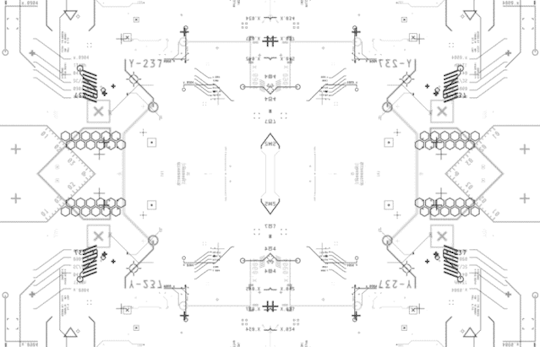
Image courtesy of Sasha Martinsen.
Sasha's idea is simple: make a few basic decent looking elements, and then just pile them on top of each other until it looks nice, maybe choose some careful colors, move them around a bit, place them around tastefully in 3D, et voilà, you're hacking the Gibson. It's something I attempted before, if somewhat unsuccessfully, in "Reboot", but I came back to it a few more times in my little private motion graphics experiments with much better results, and my prediction was that it would be doable in the given timeframe - or at least I hoped that my hazy 3AM brain was on the right track.
A bit of math
How to make this whole thing work? First, let's think about our rendering: We have a single rectangle and a single-pass shader that runs on it: this means no meshes, no geometry, no custom textures, no postprocessing, no particle systems and no fonts, which isn't a good place to start from. However, looking at some of Sasha's 3D GIFs, some of them look like they're variations of the same render put on planes one after the other - and as long as we can do one, we can do multiple of that.

Rough sketch of what we want to do; the planes would obviously be infinite in size but this representation is good enough for now.
Can we render multiple planes via a single shader? Sure, but we want them to look nice, and that requires a bit of thinking: The most common technique to render a "2D" shader and get a "3D" look is raymarching, specifically with signed distance fields - starting on a ray, and continually testing distances until a hit is found. This is a good method for "solid-ish" looking objects and scenes, but the idea for us is to have many infinite planes that also have some sort of alpha channel, so we'd have a big problem with 1) inaccuracy, as we'd never find a hit, just something "reasonably close", and even that would take us a few dozen steps, which is costly even for a single plane and 2) the handling of an alpha map can be really annoying, since we'd only find out our alpha value after our initial march, after which if our alpha is transparent we'd need to march again.
But wait - it's just infinite planes and a ray, right? So why don't we just assume that our ray is always hitting the plane (which it is, since we're looking at it), and just calculate an intersection the analytical way?
Note: I would normally refer to this method as "raytracing", but after some consultation with people smarter than I am, we concluded that the terms are used somewhat ambiguously, so let's just stick to "analytical ray solving" or something equally pedantic.
We know the mathematical equation for a ray is position = origin + direction * t (where t is a scalar that represents the distance/progress from the ray origin), and we know that the formula for a plane is A * x + B * y + C * z + D = 0, where (A, B, C) is the normal vector of the plane, and D is the distance from the origin. First, since the intersection will be the point in space that satisfies both equations, we substitute the ray (the above o + d * t for each axis) into the plane:
A * (ox + dx * t) + B * (oy + dy * t) + C * (oz + dz * t) + D = 0
To find out where this point is in space, we need to solve this for t, but it's currently mighty complicated. Luckily, since we assume that our planes are parallel to the X-Y plane, we know our (A, B, C) normal is (0, 0, 1), so we can simplify it down to:
oz + dz * t + D = 0
Which we can easily solve to t:
t = (D - oz) / dz
That's right: analytically finding a ray hit of a plane is literally a single subtraction and a division! Our frame rate (on this part) should be safe, and we're always guaranteed a hit as long as we're not looking completely perpendicular to the planes; we should have everything to start setting up our code.
Full disclosure: Given my (and in a way IQ's) lack of "live coding" experience, we agreed that there would be no voting for the round, and it'd be for glory only, but also that I'd be allowed to use a small cheat sheet of math like the equations for 2D rotation or e.g. the above final equation since I don't do this often enough to remember these things by heart, and I only had a few hours notice before the whole thing.
Setting up the rendering
Time to start coding then. First, let's calculate our texture coordinates in the 0..1 domain using the screen coordinates and the known backbuffer resolution (which is provided to us in Bonzomatic):
vec2 uv = vec2(gl_FragCoord.x / v2Resolution.x, gl_FragCoord.y / v2Resolution.y);
Then, let's create a ray from that:
vec3 rayDir = vec3( uv * 2 - 1, -1.0 ); rayDir.x *= v2Resolution.x / v2Resolution.y; // adjust for aspect ratio vec3 rayOrigin = vec3( 0, 0, 0 );
This creates a 3D vector for our direction that is -1,-1,-1 in the top left corner and 1,1,-1 in the bottom right (i.e. we're looking so that Z is decreasing into the screen), then we adjust the X coordinate since our screen isn't square, but our coordinates currently are - no need to even bother with normalizing, it'll be fine. Our origin is currently just sitting in the center.
Then, let's define (loosely) our plane, which is parallel to the XY plane:
float planeDist = 1.0f; // distance between each plane float planeZ = -5.0f; // Z position of the first plane
And solve our equation to t, as math'd out above:
float t = (planeZ - rayOrigin.z) / rayDir.z;
Then, calculate WHERE the hit is by taking that t by inserting it back to the original ray equation using our current direction and origin:
vec3 hitPos = rayOrigin + t * rayDir;
And now we have our intersection; since we already know the Z value, we can texture our plane by using the X and Y components to get a color value:
vec4 color = fui( hitPos.xy ); // XY plane our_color = color;
Of course we're gonna need the actual FUI function, which will be our procedural animated FUI texture, but let's just put something dummy there now, like a simple circle:
vec4 fui ( vec2 uv ) { return length(uv - 0.5) < 0.5 ? vec4(1) : vec(0); }
And here we go:

Very good, we have a single circle and if we animate the camera we can indeed tell that it is on a plane.
So first, let's tile it by using a modulo function; the modulo (or modulus) function simply wraps a number around another number (kinda like the remainder after a division, but for floating point numbers) and thus becomes extremely useful for tiling or repeating things:

We'll be using the modulo function rather extensively in this little exercise, so strap in. (Illustration via the Desmos calculator.)
vec4 layer = fui( mod( hitPos.xy, 1.0 ) );
This will wrap the texture coordinates of -inf..inf between 0..1:
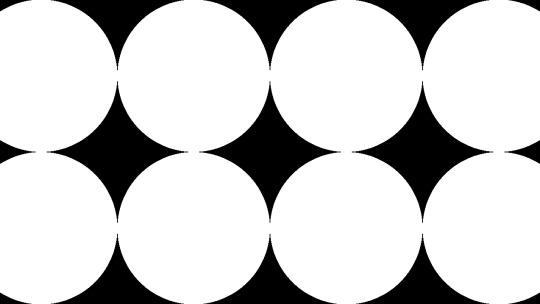
We also need multiple planes, but how do we combine them? We could just blend them additively, but with the amount of content we have, we'd just burn them in to white and it'd look like a mess (and not the good kind of mess). We could instead just use normal "crossfade" / "lerp" blending based on the alpha value; the only trick here is to make sure we're rendering them from back to front since the front renders will blend over the back renders:
int steps = 10; float planeDist = 1.0f; for (int i=steps; i>=0; i--) { float planeZ = -1.0f * i * planeDist; float t = (planeZ - rayOrigin.z) / rayDir.z; if (t > 0.0f) // check if "t" is in front of us { vec3 hitPos = rayOrigin + t * rayDir; vec4 layer = fui( hitPos.xy, 2.0 ); // blend layers based on alpha output colour = mix( colour, layer, layer.a ); } }
And here we go:

We decreased the circles a bit in size to see the effect more.
Not bad! First thing we can do is just fade off the back layers, as if they were in a fog:
layer *= (steps - i) / float(steps);
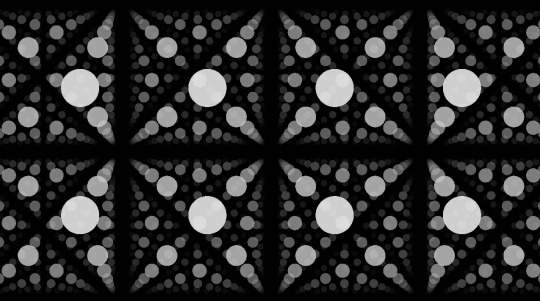
We have a problem though: we should probably increase the sci-fi effect by moving the camera continually forward, but if we do, we're gonna run into a problem: Currently, since our planeZ is fixed to the 0.0 origin, they won't move with the camera. We could just add our camera Z to them, but then they would be fixed with the camera and wouldn't appear moving. What we instead want is to just render them AS IF they would be the closest 10 planes in front of the camera; the way we could do that is that if e.g. our planes' distance from each other is 5, then round the camera Z down to the nearest multiple of 5 (e.g. if the Z is at 13, we round down to 10), and start drawing from there; rounding up would be more accurate, but rounding down is easier, since we can just subtract the division remainder from Z like so:
float planeZ = (rayOrigin.z - mod(rayOrigin.z, planeDist)) - i * planeDist;
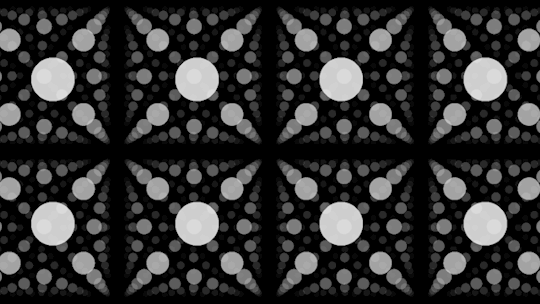
And now we have movement! Our basic rendering path is done.
Our little fictional UI
So now that we have the basic pipeline in place, let's see which elements can we adapt from Sasha's design pieces.
The first one I decided to go with wasn't strictly speaking in the set, but it was something that I saw used as design elements over the last two decades, and that's a thick hatch pattern element; I think it's often used because it has a nice industrial feel with it. Doing it in 2D is easy: We just add X and Y together, which will result in a diagonal gradient, and then we just turn that into an alternating pattern using, again, the modulo. All we need to do is limit it between two strips, and we have a perfectly functional "Police Line Do Not Cross" simulation.
return mod( uv.x + uv.y, 1 ) < 0.5 ? vec4(1) : vec4(0);

So let's stop here for a few moments; this isn't bad, but we're gonna need a few things. First, the repetition doesn't give us the nice symmetric look that Sasha recommends us to do, and secondly, we want them to look alive, to animate a bit.
Solving symmetry can be done just by modifying our repetition code a bit: instead of a straight up modulo with 1.0 that gives us a 0..1 range, let's use 2.0 to get a 0..2 range, then subtract 1.0 to get a -1..1 range, and then take the absolute value.

vec4 layer = fui( abs( mod( hitPos.xy, 2.0 ) - 1 ) );
This will give us a triangle-wave-like function, that goes from 0 to 1, then back to 0, then back to 1; in terms of texture coordinates, it will go back and forth between mirroring the texture in both directions, which, let's face it, looks Totally Sweet.
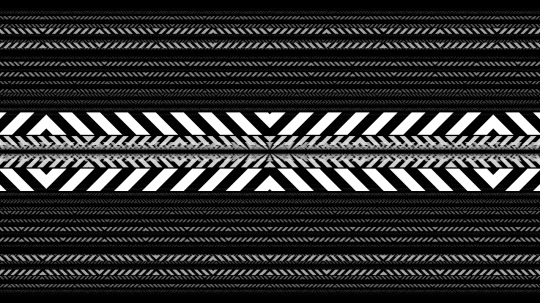
For animation, first I needed some sort of random value, but one that stayed deterministic based on a seed - in other words, I needed a function that took in a value, and returned a mangled version of it, but in a way that if I sent that value in twice, it would return the same mangled value twice. The most common way of doing it is taking the incoming "seed" value, and then driving it into some sort of function with a very large value that causes the function to alias, and then just returning the fraction portion of the number:
float rand(float x) { return fract(sin(x) * 430147.8193); }
Does it make any sense? No. Is it secure? No. Will it serve our purpose perfectly? Oh yes.
So how do we animate our layers? The obvious choice is animating both the hatch "gradient" value to make it crawl, and the start and end of our hatch pattern which causes the hatched strip to move up and down: simply take a random - seeded by our time value - of somewhere sensible (like between 0.2 and 0.8 so that it doesn't touch the edges) and add another random to it, seasoned to taste - we can even take a binary random to pick between horizontal and vertical strips:
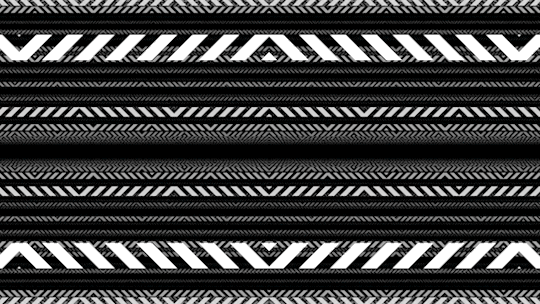
The problems here are, of course, that currently they're moving 1) way too fast and 2) in unison. The fast motion obviously happens because the time value changes every frame, so it seeds our random differently every frame - this is easy to solve by just rounding our time value down to the nearest integer: this will result in some lovely jittery "digital" motion. The unison is also easy to solve: simply take the number of the layer, and add it to our time, thus shifting the time value for each layer; I also chose to multiply the layer ID with a random-ish number so that the layers actually animate independently, and the stutter doesn't happen in unison either:
vec4 fui( vec2 uv, float t ) { t = int(t); float start = rand(t) * 0.8 + 0.1; float end = start + 0.1; [...] } vec4 layer = fui( abs(mod(hitPos.xy, 2.0)-1), fGlobalTime + i * 4.7 );

Lovely!
Note: In hindsight using the Z coordinate of the plane would've given a more consistent result, but the way it animates, it doesn't really matter.
So let's think of more elements: the best looking one that seems to get the best mileage out in Sasha's blog is what I can best describe as the "slant" or "hockey stick" - a simple line, with a 45-degree turn in it. What I love about it is that the symmetry allows it to create little tunnels, gates, corridors, which will work great for our motion.
Creating it is easy: We just take a thin horizontal rectangle, and attach another rectangle to the end, but shift the coordinate of the second rectangle vertically, so that it gives us the 45-degree angle:
float p1 = 0.2; float p2 = 0.5; float p3 = 0.7; float y = 0.5; float thicc = 0.0025; if (p1 < uv.x && uv.x < p2 && y - thicc < uv.y && uv.y < y + thicc ) { return vec4(1); } if (p2 < uv.x && uv.x < p3 && y - thicc < uv.y - (uv.x - p2) && uv.y - (uv.x - p2) < y + thicc ) { return vec4(1); }
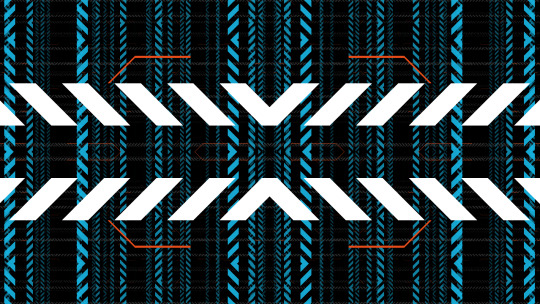
Note: In the final code, I had a rect() call which I originally intended to use as baking glow around my rectangle using a little routine I prototyped out earlier that morning, but I was ultimately too stressed to properly pull that off. Also, it's amazing how juvenile your variable names turn when people are watching.
Looks nice, but since this is such a thin sparse element, let's just... add more of it!
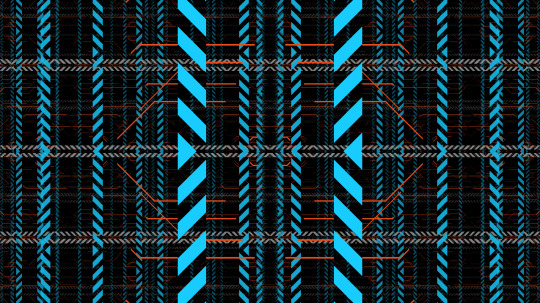
So what more can we add? Well, no sci-fi FUI is complete without random text and numbers, but we don't really have a font at hand. Or do we? For years, Bonzomatic has been "shipping" with this really gross checkerboard texture ostensibly for UV map testing:

What if we just desaturate and invert it?
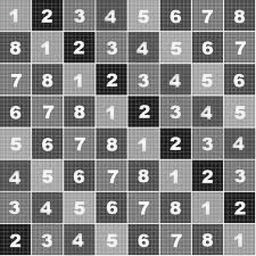
We can then "slice" it up and render little sprites all over our texture: we already know how to draw a rectangle, so all we need is just 1) calculate which sprite we want to show 2) calculate the texture coordinate WITHIN that sprite and 3) sample the texture:
float sx = 0.3; float sy = 0.3; float size = 0.1; if (sx < uv.x && uv.x < sx + size && sy < uv.y &&uv.y < sy + size) { float spx = 2.0 / 8.0; // we have 8 tiles in the texture float spy = 3.0 / 8.0; vec2 spriteUV = (uv - vec2(sx,sy)) / size; vec4 sam = texture( texChecker, vec2(spx,spy) + spriteUV / 8.0 ); return dot( sam.rgb, vec3(0.33) ); }
Note: In the final code, I was only using the red component instead of desaturation because I forgot the texture doesn't always have red content - I stared at it for waaaay too long during the round trying to figure out why some sprites weren't working.
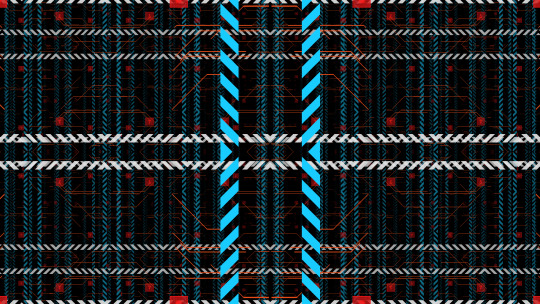
And again, let's just have more of it:
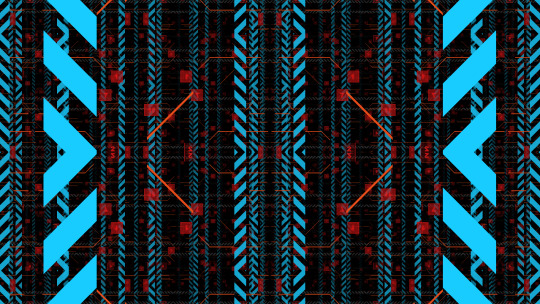
Getting there!
At this point the last thing I added was just circles and dots, because I was running out of ideas; but I also felt my visual content amount was getting to where I wanted them to be; it was also time to make it look a bit prettier.
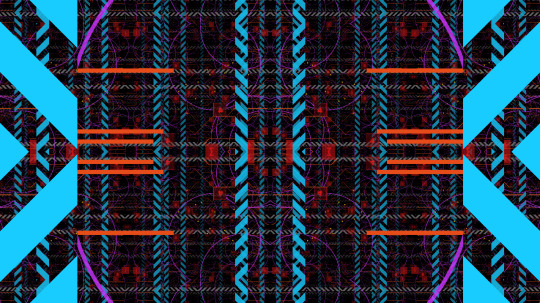
Post-production / compositing
So we have our layers, they move, they might even have colors, but I'm still not happy with the visual result, since they are too single-colored, there's not enough tone in the picture.
The first thing I try nowadays when I'm on a black background is to just add either a single color, or a gradient:
vec4 colour = renderPlanes(uv); vec4 gradient = mix( vec4(0,0,0.2,1), vec4(0,0,0,1), uv.y); vec4 finalRender = mix( gradient, vec4(colour.xyz,1), colour.a);

This added a good chunk of depth considerably to the image, but I was still not happy with the too much separation between colors.
A very common method used in compositing in digital graphics is to just add bloom / glow; when used right, this helps us add us more luminance content to areas that would otherwise be solid color, and it helps the colors to blend a bit by providing some middle ground; unfortunately if we only have a single pass, the only way to get blur (and by extension, bloom) is repeatedly rendering the picture, and that'd tank our frame rate quickly.
Instead, I went back to one of the classics: the Variform "pixelize" overlay:
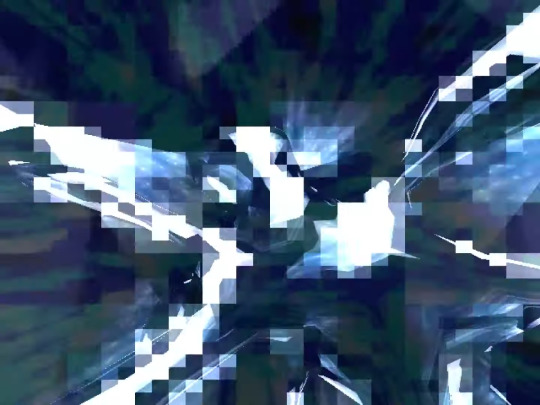
This is almost the same as a bloom effect, except instead of blurring the image, all you do is turn it into a lower resolution nearest point sampled version of itself, and blend that over the original image - since this doesn't need more than one sample per pixel (as we can reproduce pixelation by just messing with the texture coordinates), we can get away by rendering the scene only twice:
vec4 colour = renderPlanes(uv); colour += renderPlanes(uv - mod( uv, 0.1 ) ) * 0.4;
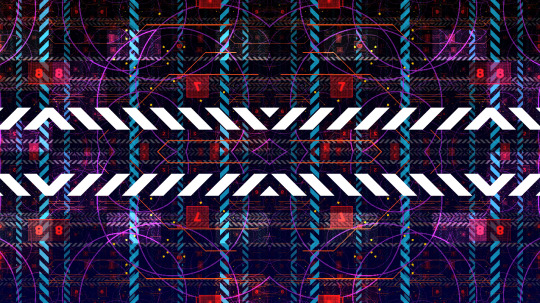
Much better tonal content!
So what else can we do? Well, most of the colors I chose are in the blue/orange/red range, and we don't get a lot of the green content; one of the things that I learned that it can look quite pretty if one takes a two-tone picture, and uses color-grading to push the midrange of a third tone - that way, the dominant colors will stay in the highlights, and the third tone will cover the mid-tones. (Naturally you have to be careful with this.)
"Boosting" a color in the mids is easy: lucky for us, if we consider the 0..1 range, exponential functions suit our purpose perfectly, because they start at 0, end at 1, but we can change how they get here:
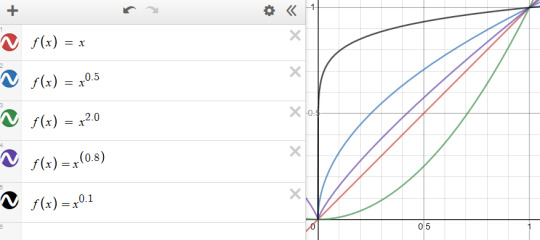
So let's just push the green channel a tiny bit:
finalRender.g = pow(finalRender.g, 0.7);
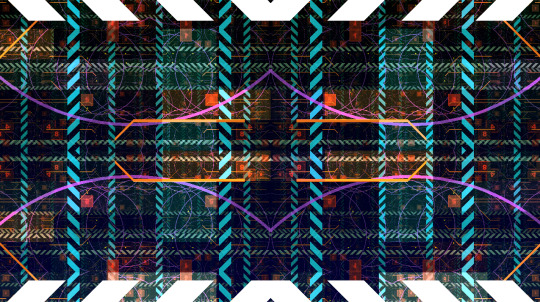
Now all we need is to roll our camera for maximum cyberspace effect and we're done!
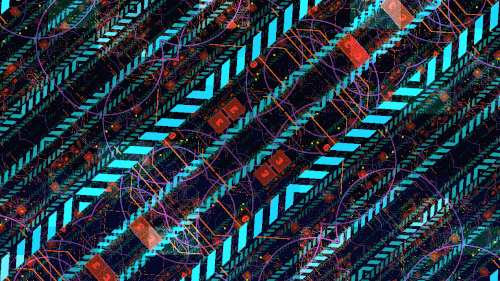
Best laid plans of OBS
As you can see from the code I posted the above, I wrote the final shader in GLSL; those who know me know that I'm a lot more comfortable with DirectX / HLSL, and may wonder why I switched, but of course there's another story here:
Given the remote nature of the event, all of the shader coding competition was performed online as well: since transmitting video from the coder's computer to a mixer, and then to another mixer, and then to a streaming provider, and then to the end user would've probably turned the image to mush, Alkama and Nusan came up with the idea of skipping a step and rigging up a version of Bonzo that ran on the coder's computer, but instead of streaming video, it sent the shader down to another instance of Bonzo, running on Diffty's computer, who then captured that instance and streamed it to the main Revision streaming hub. This, of course, meant that in a three-way, Diffty had to run three separate instances of Bonzo - but it worked fine with GLSL earlier, so why worry?
What we didn't necessarily realize at the time, is that the DirectX 11 shader compiler takes no hostages, and as soon as the shader reached un-unrollable level of complexity, it thoroughly locked down Diffty's machine, to the point that even the video of the DJ set he was playing started to drop out. I, on the other hand, didn't notice any of this, since my single local instance was doing fine, so I spent the first 15 minutes casually nuking Diffty's PC to shreds remotely, until I noticed Diffty and Havoc pleading on Discord to switch to GLSL because I'm setting things on fire unknowingly.
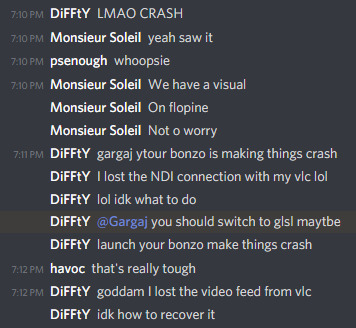
This is fine.
I was reluctant to do so, simply because of the muscle memory, but I was also aware that I should keep the show going if I can because if I bow out without a result, that would be a colossal embarrassment to everyone involved, and I only can take one of those once every week, and I was already above my quota - so, I quickly closed the DX11 version of Bonzo, loaded the shader up in a text editor, replaced "floatX" with "vecX" (fun drinking game: take a shot every time I messed it up during the live event), commented the whole thing out, loaded it into a GLSL bonzo, and quickly fixed all the other syntax differences (of which there were luckily not many, stuff like "mix" instead of "lerp", constructors, etc.), and within a few minutes I was back up and running.
This, weirdly, helped my morale a bit, because it was the kind of clutch move that for some reason appealed to me, and made me quite happy - although at that point I locked in so bad that not only did I pay absolutely not attention to the stream to see what the other two are doing, but that the drinks and snacks I prepared for the hour of battling went completely untouched.
In the end, when the hour clocked off, the shader itself turned out more or less how I wanted it, it worked really well with Bullet's techno-/psy-/hardtrance mix (not necessarily my jam, as everyone knows I'm more a broken beat guy, but pounding monotony can go well with coding focus), and I came away satisfied, although the perhaps saddest point of the adventure was yet to come: the lack of cathartic real-life ending that was taken from us due to the physical distance, when after all the excitement, all the cheers and hugs were merely lines of text on a screen - but you gotta deal with what you gotta deal with.
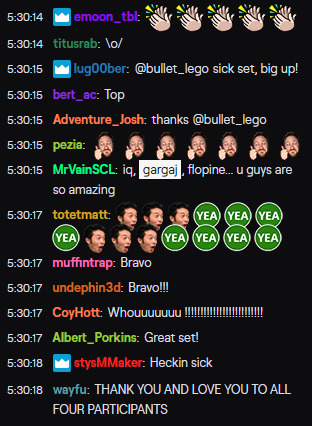
A small sampling of the Twitch reaction.
Conclusion
In the end, what was my takeaway from the experience?
First off, scoping is everything: Always aim to get an idea where you can maximize the outcome of the time invested with the highest amount of confidence of pulling it off. In this case, even though I was on short notice and in an environment I was unfamiliar with, I relied on something I knew, something I've done before, but no one else really has.
Secondly, broaden your influence: You never know when you can take something that seems initially unrelated, and bend it into something that you're doing with good results.
Thirdly, and perhaps most importantly, step out of your comfort zone every so often; you'll never know what you'll find.
(And don't agree to everything willy-nilly, you absolute moron.)
10 notes
·
View notes
Note
im actually super interested in hearing your thoughts regarding the state of polygon
oh thank you uhhhh this is gonna be a long response...
so my Thots™ essentially boil down to: polygon is in a kinda flux state and has been for a while and I think 2020 is when that's going to end.
with the announcement of the news show and some of the recent sponsored videos it seems like they are trying to pivot into having more traditional videos instead of the wacky stuff we have now. everyone knows late 2017 and 2018 were a huge shakeup for polygon and everything since them has been about trying to find their footing and figure out exactly what kind of content they want to be making.
with the reduction of non-series videos (and videos in general), the way they've basically given up on streaming, the loss of some Polygon Peeps™ due to various reasons.... it seems like they've settled on that identity. they have a few series that work but for the most part it's a big question mark and I think 2020 is going to set a new precedent for what polygon content /is/.
so if you're like me, this is stressful because you like the content polygon is currently producing or you prefer content that veers away from the more professional aspects of gaming. I know peak polygon for me was 2018 when jackbox and streams were common. I loved the laid back and experimental content they were making that year
but now they have a formula for success (I could do a whole post about that in regards to unraveled but I'm saying enough testy shit as is). there's also the Fear that comes with knowing how polygon retires shows,,,, which is to say they dont. when they stop series it often happens without warning. they'll call it a season finale and then never return to it (gill and gilbert) or they'll just stop making episodes and never clarify (jackbox). (this isnt even to mention the 2 season expiration date that kills shows without warning i.e. video game theatre)
basically, polygon isnt great about communicating what exactly they plan to do with shows or even just with things overall. and I feel like theres a certain amount of responsibility to keep your audience informed. and that's what makes me nervous about overboard or the potential future of unraveled because from here I only really see two possibilities. 1)these shows become the only remnant of the polygon we know now as they move into their next phase OR 2) one or both of them end moving into this new phase.
obviously this is all my speculation but given polygons track record with saying a show "will be back in a few months".... I'm skeptical. I think there are major changes on the horizon and it does make me anxious about my future in this fandom and if polygon will continue be something I care about so much in the future.
#answered#hopefully this makes some sense#and its probably just me being anxious so sorry that its a mess#and i definitely have more to say but i already feel like im bitching too much lol
21 notes
·
View notes
Text
Why I’m skeptical about the Final Fantasy VII Remake
I’m skeptical that the remake will be good because there will be a lot of changes that will impact the direction, tone and narrative of the game, and Square Enix’s track record suggests to me that those inevitable changes will destroy and undercut what was special about the original game.
An essay breaking that down piece by piece is under the cut.
There will be a lot of changes
The remake will represent a huge and doubtlessly beautiful graphical update. With these updates, however, comes the need for a variety of new directorial decisions. For example, how should the camera behave during cutscenes? Who should they frame, and how? What will their body language and facial expressions show? Now that all the cutscenes will be voice acted, what tone will characters speak familiar lines with?
Likewise, the game is switching to a third-person, over-the-shoulder view. The original FFVII used a fixed camera and prerendered backgrounds to create a world that felt rich, full, and often cluttered. Every level will require redesign to account for the new way of moving about the world, and the amount of assets required to create the same feeling and to direct your attention in a same way will be exponentially higher. Likewise, there will need to be changes to account for the new combat system, as stages will need to be designed for both exploration and combat in many cases.
The episodic format of the game will necessitate changes to the pacing. Successful episodic games excel at creating self-contained rising and falling action and narrative arcs within each episode. Conversely, Final Fantasy VII was plotted and paced as a single complete narrative. Either the pace and order of events will need to be changed to make each episode stand strongly on its own, or the episodes on their own will be gawky and suffer pacing issues as they are pulled out of context from the greater whole.
Finally, the narrative itself will change. We have yet to see a verbatim line in each of the trailers, so the script itself is being rewritten, and with it many nuances will change. Square has stated point-blank that story changes are on the table. Finally, the compilation of Final Fantasy VII and the various Ultimanias released over the years have added a variety of changes to the narrative and to the lore. The teaser trailers we’ve seen so far have been in-line with the Midgar we see in Advent Children, itself a massive change to the famously ambiguous ending of the original game.
Direction and tone will be affected
All of these changes will not be neutral. In just about every decision of how this story is retold, some things are necessarily going to be emphasized and de-emphasized. Each of these decisions will carry and shift meaning in subtle ways. In that sense, the remake should more truly be considered an adaptation.
Examine the opening of FFVII; a meandering view of the stars fades into Aeris’ face. A single long shot pulls back to the city of Midgar. The tone here is mysterious, and the amount of time dedicated to the environment equals or surpasses the time spent on a character. This direction in cinematography echoes the game’s focus, as it is very much a story about the interplay between the characters as they exist inside of larger, overwhelming forces and environments.
The remake does have the opportunity to give us more meaningful cinematography in its cutscenes, but it may also make directorial decisions that change the meaning or impact of scenes. Especially likely is an increased focus on the characters and the action, and implicitly, the “cool” factor of both of those things, seeing as how the Remake and Square Enix as a company largely foreground great visuals and cool sequences. There’s absolutely room for that, of course, considering the bike scene in the original - but the broader point here is that no intervention can be neutral, and the Remake will inevitably have a different focus from the original.
One influential decision the writers have made is in their audience. All promotional material thus far has been aimed squarely at “returning” players, with no explanations offered for newcomers. What we’ve seen so far is in line with the marketing material - they are not simply trying to recreate FFVII as it was, but also tap into our collective sense of familiarity about it. The direct engagement with an expected audience means they will likely try to recreate the feeling of the experience rather than the experience itself, which would then necessitate certain story changes to keep things surprising or mysterious. This approach will inevitably widen the gulf between the remake and the original game.
SquareEnix’s Track Record
SquareEnix has been behind many beloved games, but they are not the company they were when they released FFVII. Their track record over the past decade, maybe even closer to the past 15 years, has been one of spotty quality, half-baked ideas, poor execution, and a narrative flexibility that suggests a lack of commitment to telling a story with singular vision and protecting the integrity of that story. Whatever your opinion or personal enjoyment of more recent Final Fantasy entries, they objectively lack the clarity and direction that made older entries of this series so beloved. To be completely clear, it is not that I believe these stories could never get there; it is that I’m keenly aware of the fact that they came short.
But more relevant than Square’s entries in the mainline Final Fantasy franchise are the entries to the Compilation of FFVII. These, two, have come with a variety of directorial changes that the new format and technology demanded. They’ve built their own lexicon that will likely be drawn upon in the creation of the remake, and that bring subtle changes along with them. For instance - Advent Children’s visually spectacular fight scenes introduced us to the idea that the characters were all able to leap vast distances and perform acrobatics mid-fight, and we’ve seen this idea carried forward into all subsequent entries of the series, even though it’s somewhat at odds with the more grounded, cyberpunk tone of the original game that earmarked these kinds of superhuman abilities as specifically unusual.
That may seem like a minor quibble, but I would argue that it’s a series of minor changes that have led to the difference in tone and focus between the compilation and the original game, and it comes down to a variety of directorial decisions that continue to be pertinent. For example, in Advent Children, the writing team made a decision to base Cloud’s character around what people would most remember from the game, and decided that would probably be the Cloud that we see at the beginning of the game. This decision was in play as early as his cameo in Kingdom Hearts, and for as inconsequential as it may have seemed then, it’s carried a rippling effect with it. By choosing to write the character in a way that they felt most fans would recognize, they also chose to downplay the growth and the specific quirks that wound up making that character interesting - a repeated issue with many of the characters.
Likewise, because the compilation prioritizes its returning Final Fantasy VII fans, it also tends to prioritize fanservice and recognizable, digestable moments over the overarching narrative of the world of Final Fantasy VII. One memorable example would be a cute Yuffie cameo in the midst of the Wutai War in Crisis Core, a war we are told repeatedly was extremely brutal and which actually destroyed Yuffie’s home and embittered her for years thereafter. The result is a story that’s at odds with itself due to tonal and character inconsistency. The prioritization of a quick moment of familiar joy robs the character of her impact in the long term, and this pattern is repeated for many other characters throughout.
Of course, the compilation has changed more than tone and framing of characters, and has also contributed several ideas to the world of Final Fantasy VII that are now in play. For example, the idea that upon death, people return to the Lifestream, whereby their spiritual energy is used by the planet to create new life. This is a distinctly animist idea that the Compilation has leaned away from, as they cannot cameo dead characters if those characters have since been reincarnate as trees. The compilation has since introduced the notion that a person’s soul and consciousness not only stays intact, but that they can come into contact with the living - an idea that’s fundamentally at odds with the themes of life, loss, death, existentialism and uncertainty that are extant in the original game.
Finally, though not least significantly, Polygon’s An Oral History of Final Fantasy 7 reveals that the reason Advent Children and subsequently the compilation was created was to save Square Enix from financial ruin, not to continue the story for its own sake. It is important to acknowledge the reality that Final Fantasy VII is bankable, and the reason for the remake to begin with may very well be that bankability rather than a good faith intention to retell a story that touched many. The episodic nature of the release does nothing to help that faith, nor does the fact that initial development was outsourced to a third party.
What was so special about FFVII
“So what?” you might ask. Even if there are a ton of changes, and those change the direction and tone of the game, does that really mean it won’t or can’t be good? To that - the jury is out. But I don’t particularly care if the FFVII remake is a good video game - I care if it’s a good representation of FFVII.
I admit without reservation that FFVII is, to use a technical term, anime trash. It has lots of rule of cool sequences that keep the game light, bits of spotty translation, and narrative stumbles. It is not a perfect work. But there is a reason why it was enduring; there was meaning to it, and that meaning was what made it special and unique.
FFVII was a ponderous game. It seldom presented an idea without later exploring and unpacking it. Its characters are seldom what they appear, the mission they undergo is hardly as noble as it seems, and what you expected to happen simply didn’t. It’s rife with deliberate ambiguity and doesn’t work overly hard to explain itself. Its story is shot through with uncertainty, about identity, faith, morality, justice, and every other waymark we use to navigate our life. Its most memorable moments rest in the loss of that certainty, and its most triumphant in the character’s perseverance regardless.
Though FFVII is primarily remembered and beloved for how it made people feel, it wasn’t written to be deliberately provocative or emotionally manipulative. The story was deeply impacted by a real-world loss, and the mandate of the team at the time was to convey that loss for how it truly felt, without the celluloid gloss and tropes like a dying speech that have since proliferated through the compilation. There was an honesty, an integrity and a complexity to this story that caused people to argue in earnest that it was the first video game that could truly be considered a piece of art.
I think the ephemeral nature of these qualities often leads people to conclude that FFVII is mainly loved due to “nostalgia,” but that’s a dismissive take that fails to acknowledge the deliberateness and consistency of its themes and ideas. The same care has very obviously not been given to any of the subsequent FFVII games.
In other words: this was never going to be an easy game to remake. A remake worthy of standing on the same pedestal as the original would require the same careful dedication to thematic consistency and integrity, to tone and feeling as the original. It would require careful thought to the impact and presentation of each of the monumental changes demanded by the new technology and platform.
Square-Enix has yet to do anything to suggest that it is up to this task. I have tremendous empathy for the development team that is taking on this task, but that doesn’t mean I have faith in their ability to really, truly, pull it off.
97 notes
·
View notes
Text
Best AutoCAD Training Course Institute
Our Institute provides Best Autocad Training in as per the current industry standards. Our training programs will enable professionals to secure placements in MNCs. Our Institute is one of the most recommended Autocad Training Institute in that offers hands on practical knowledge / practical implementation on live projects and will ensure the job with the help of advance level Autocad Training Courses. At Our Institute Autocad Training in is conducted by specialist working certified corporate professionals having 8+ years of experience in implementing real-time Autocad.
ENQUIRY NOW
Our Institute is well-equipped Autocad Training Center. Candidates will implement the following concepts – Coordinate Systems, Drawing Lines & Circles., Erasing Object., Canceling & Undoing A Command, Inputting Data, Creating Basic Objects, Using Object Snaps, Using Polar Tracking And Polar Snap, Using Object Snap Tracking, Working With Units etc. on real time projects along with Autocad Placement Training modules like aptitude test preparation etc.
Our Institute is the well-known Autocad Training Center in with high tech infrastructure and lab facilities. We also provide online access of servers so that candidates will implement the projects at their home easily. Our Institute in mentored more than 3000+ candidates with Autocad Certification Training in at very reasonable fee. The course curriculum is customized as per the requirement of candidates/corporates.
In addition to this, our classrooms are built-in with projectors that facilitate our students to understand the topic in a simple manner.
Our Institute is one of the best Autocad Training Institutes in with 100% placement support. We are following the below “P3-Model (Placement Preparation Process)” to ensure the placement of our candidates: View Our Latest Placement Record.
Our strong associations with top organizations like HCL, Wipro, Dell, Birlasoft, TechMahindra, TCS, IBM etc. makes us capable to place our students in top MNCs across the globe. We have placed thousands of students according to their skills and area of interest that makes us preferred Autocad Training Institute in . Next, we closely monitor the growth of students during training program and assist them to increase their performance and level of knowledge.
Autocad Training Overview
AutoCAD is a computer-aided design (CAD) program used for 2-D and 3-D design and drafting. AutoCAD is developed and marketed by Autodesk Inc. and was one of the first CAD programs that could be executed on personal computers.
CONTACT US
AutoCAD was initially derived from a program called Interact, which was written in a proprietary language. The first release of the software used only primitive entities such as polygons, circles, lines, arcs and text to construct complex objects. Later, it came to support custom objects through a C++ application programming interface. The modern version of the software includes a full set of tools for solid modeling and 3-D. AutoCAD also supports numerous application program interfaces for automation and customization.
DWG (drawing) is the native file format for AutoCAD and a basic standard for CAD data interoperability. The software has also provided support for Design Web Format (DWF), a format developed by Autodesk for publishing CAD data.
Why you should Join Our Institute for Autocad Training in Reasons which makes us best among all others:
We provide video recording tutorials of the training sessions, so in case if candidate missed any class he/she can utilize those video tutorials.
All our training programs are based on live industry projects.
All our training programs are based on current industry standards.
Our training curriculum is approved by our placement partners.
Training will be conducted on daily& weekly basis and also, we can customize the training schedule as per the candidate requirements.
Live Project based training with trainers having 5 to 15 years of Industry Experience.
Training will be conducted by certified professionals.
Our Labs are very well-equipped with latest version of hardware and software.
Our classrooms are fully geared up with projectors &Wi-Fi access. 100 % free personality development classes which includes Spoken English, Group Discussions, Mock Job interviews & Presentation skills.
You will get study material in form of E-Book’s, Online Videos, Certification Handbooks, Certification Dumps and 500 Interview Questions along with Project Source material.
Worldwide Recognized Course Completion Certificate, once you’ve completed the course.
Flexible Payment options such as Cheque, EMI, Cash, Credit Card, Debit Card and Net Banking.
#Best AutoCAD Training Course Institute#AutoCAD Training#AutoCAD Course#AutoCAD Institute#AutoCAD Training Course#AutoCAD Training institute#AutoCAD Course institute
1 note
·
View note
Text
The Story Of Merge Data, The Indie Label That Obtained Large And Stayed Small
You would need another program to combine MP3s. I really feel like perhaps I have missed one thing with Free MP3 Cutter Joiner. It looks like two separate purposes that have been joined by an disagreeable interface which tries its most interesting to confuse. It does what it claims, however poorly at finest. Add your mp3 information, than click on "merge" button to merge. To use open monitoring in mail merge, it is advisable allow the Monitor E mail Opens possibility within the Mail Merge configure window. You additionally need to specify a Marketing campaign Identify as shown in the screenshot below. You should use this online audio merger program to merge MP3 recordsdata, merge mp3s merge WAV information, merge OGG files, merge AAC files or merge M4A files etc. MP3 Joiner lets you add equal size or completely different size of silence between the tracks you are going to merge. Whenever you merge tracks, the tracks are changed with a single monitor containing a stereo audio file in a brand new copy of the song. The original tune is available within the My Songs browser, so you possibly can edit the unique tracks. Useful Audio Editor is a multi-functional device for modifying audio recordsdata as an audio trimmer, merger and recorder on iPhone and iPad. You should utilize this app to chop and merge MP3 information. And you too can record songs in your personal voice with its recording options. After reducing, merging or recording, it can also by an audio player to let your hear the music immediately. You can share your audio files in a number of audio codecs in addition to MP3 like CAF, AIFF, WAV, M4A, AU to your system. Audios might be access from iTunes when iPhone or iPad related with computer. Gymnastics was first released on tape through Sister Polygon in 2015, then through France's Hazard Data later that yr (on Bandcamp, the French label aptly filed it underneath Messmerizing sic minimal, pounding bass, Post Punk spoken word! You want it!"). Katie Alice Greer, vocalist in D.C. quartet Clergymen, co-founder of Sister Polygon, and friend of Moolchan's says she urged her to release the tape in order that her songs may attain a wider audience. We were like ‘Dude, let us put this out on Sister Polygon,' because we were head over heels for the songs," she says. And other people had been too. I feel the entire tape front and merge MP3s back is perfect." Gymnastics soon tumbled into the fitting ears: Moolchan says she received an electronic mail from Merge in her inbox last 12 months, and now, Merge has reissued Gymnastics on vinyl and CD. She has plans to release new music on the label early subsequent year. I not too long ago revisited a previous how-to I wrote up two years in the past, pondering that there must be a better option to losslessly mix quite a lot of MP3 information than to make use of 3 separate utilities. After having a standard concept about this trendy and simple -to-use MP3 Merger, simply comply with the three steps as confirmed under to combine plenty of MP3 information with it. It preserves the first monitor's media data for the brand new mp3 - not a large issue, simply prompted duplicate tracks for me.
Step 1. Open this system and click on on the Select files" icon. Choose the recordsdata to merge and click Open" on the information explorer to add them. You can too drag and drop them to this system. Simple MP3 Joiner is a fast utility to merge MP3 and WAV recordsdata. You possibly can choose the order of recordsdata to be joined, edit their ID3 tags if desired, insert silence between fragments, take heed to source recordsdata in the constructed-in participant, set the output folder. Shift or Control-click (Command-click for Mac OS) to pick out the audio-only clips you wish to merge with the video clip. To start out with its mp3 merger operate it is advisable to install it first and launch it. Now on the Audacity's interface hit File; Open and cargo all the mp3 tracks that you want to be a part of together. Mix mp3 information. Other than merging a number of information into a single track, Free Merge MP3 also can convert the songs from one audio format to a different. You want to choose the specified format and click on Convert. The software can batch convert the information, with or without merging them collectively. Merge MP3 might even seamlessly merge recordsdata between lossy and lossless formats. For instance, you may merge a bunch of FLAC and MP3 recordsdata into a single compressed mp3, aac, or ogg file, and vice versa. As an example, you'll be able to merge a bunch of FLAC and MP3 information right into a single compressed mp3, aac, or ogg file, and vice versa. Since it seems that most audiobooks I discover outside of Audible are break up right into a ton of MP3 recordsdata, I usually merge them into a single MP3, drag into iTunes, convert to AAC file, then change the extension to M4b. Visible MP3 Splitter & Joiner - A useful software program utility that can split and combine audio information. Reduce MP3 fast and easy utilizing a waveform without losses in quality. This system can merge a number of information into one massive. Supports batch processing mode. Vital Phrase: For a reason I'm not clear on I needed to run PowerShell as Administrator for FFMPEG to effectively create the merged MP3. It is open-provide freeware, accessible at sourceforge and elsewhere, for Residence home windows merge mp3s , Mac and Linux. This software program program additionally joins BAT, CSV, DAT, LOG, REG and other file formats.To start out with its mp3 merger function it is advisable install it first and launch it. Now on the Audacity's interface hit File > Open and cargo the entire mp3 tracks that you just wish to be a part of together. Official video for "Why Do You Let Me Keep Here?" by She & Him, taken from the album Quantity One, out now on Merge Records. And then you should use the audio joiner to separate or merge completely different audio clips into a ringtone or a track for yourself. It is Compatible with varied audio and video formats, you can add MP3, WAV, AAC, AIFF, WMA, and extra audio tracks to film for having fun with higher and make a beautiful video with your own audio.
1 note
·
View note
Text
Clipping Path Services and Photo Editing Services Provider Company
Clipping path service provider company
Clipping path service a great photograph can provide greater than any composed documents. Even though only some most effective illustrations or photos have this likely to capture the audience focus. This is why, one particular have to attractive photo edit to satisfy their customer element.
If the subject of the image has hair or fuzzy edges (just like a teddy bear or perhaps a fuzzy blanket) or is clear. In these eventualities, we suggest Highly developed picture masking.
Paypal is the entire world very best and customary well is aware payment system. It's going to be better In the event the clipping path service company has the paypal account.
The global on the web enterprises is totally depends upon clipping path. Whether it is an e-commerce web page or affiliate web site or know-how site, pictures are essential. And for the appropriate visuals that match your website, you need a excellent clipping path service. This is certainly my standpoint about clipping path.
These companies are definitely the frequent purchaser of those clipping Remedy companies, mainly because clipping path is currently the inspiration from the graphic industry.
cpsiadmin
clipping path service course of action is simple to be aware of. Just begin drawing from an fringe of the picture utilizing the pen tool and finish it at precisely the same edge where you start from. You will note the outlined image is seen and the rest of the image happens to be transparent.
Intricate clipping path is applicable in the photographs of things with compound and complicated styles. Style or team shots with several holes, embedded transparency, and several closed paths.
In This system, you put the subject of a photo on its own layer, and make the pixels encompassing it clear.
path service
The Performing system won't ever match with all more info other company. Unique company’s Performing process will distinctive. One can eliminate image history by utilizing the Software of magic wand, lasso Software, speedy range Software, rectangle marquee applications, polygonal lasso Software etcetera.
Not just e-commerce, but also you would like good photographs Should you be carrying out affiliate or blogging. So Here's some dilemma concerns thoughts, why images are a great deal of critical?
If you’ll be positioning your picture in QuarkXpress or InDesign, the path can be modified in this kind of way that your products will look isolated only inside your structure, and can retain its qualifications in Photoshop.
When you have a perfect clipping path, you can make your qualifications transparent working with among two methods: If you're going to be placing your graphic in InDesign or Quark (including inside of a catalog format), you can change the path to some clipping path service so which the track record will surface intact in Photoshop, although the track record are going to be transparent in the event the picture is put in InDesign.
The area of interest, Clipping Path happens to be a well known research expression in Google online search engine these days. Working day by day, the demand of clipping path services is escalating additional. The primary reason for this popularity may be the preserve time and very low labor cost.
After that, you may need to be sure with regards to the company’s qualified designer selection. Because the swift and greater consequence depend on the expert hand.
Our Services:
Clipping path service
Background removal service
Shadow making service
Image masking service
Neck joint service
Photo retouching service
Photo color correction service
Photo manipulation service
Raster to vector services
Photo restoration service
eCommerce image editing service
Jewelry photo editing
Bike photo editing service
Car photo editing
Real estate photo editing service
clipping path service provider company
1 note
·
View note
Photo
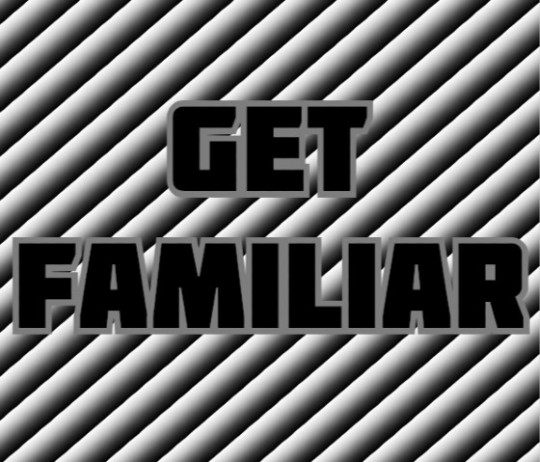
GET FAMILIAR: Week of February 18, 2019
Welcome to Get Familiar, a breakdown of the standout music releases you should be on the lookout for in the week ahead! Posts will feature three releases that will be placed into the following categories: Coming Soon, Local Legends, and Wild Cards. The “Coming Soon” category will highlight an artist whose tour will be touching down in DC sometime in the near future, while “Local Legends” will feature artists hailing from the DMV, and “Wild Cards” will showcase a release that the Half-Past team is beyond stoked about!
Check back each week on Monday to find your next favorite artist and to be the first to know about the latest drops from those who are already in heavy rotation in your headphones. Get familiar, and get to listening!
COMING SOON: GARY CLARK JR.
Release Title: This Land (LP)
Release Date: Friday, February 22, 2019
What To Expect: There’s a reason that Austin, Texas native Gary Clark Jr. was dubbed “The Chosen One” by Rolling Stone and frequently receives comparisons to the likes of his idol Stevie Ray Vaughan and Eric Clapton, the latter of which is such a big fan that he once wrote a letter to Clark as a thank you for inspiring him to play again. He’s the type of guitarist that can define a generation, and he’s still only just begun his ascent to stardom. The release of his next studio-album, This Land, should send shockwaves through the music world, and, judging by the reception he’s received to the project’s first three singles, it should cement his status as blues-rock royalty.
Just over two weeks ago, Clark blessed us with the first two singles: “I Walk Alone” and “This Land.” Both songs showcase his talents in a new light, with the former serving as a funky display of his vocal range and the latter being a psychedelic, electro-laden anthem that sees the singer commenting on our country’s equality imbalance and his frustrations with those that have seemingly only accepted him for his newfound success. Not content with stopping there, he released the final single for the album, “Pearl Cadillac,” late last week. The song is a soulful love ballad that sees Clark fawning over a lost love, and possibly attempting to rekindle the flame. It’s a beautiful track, but the Texan made sure to include a face-melting solo that is sure to knock any listener off their seat. All three songs are exciting exhibits of his growth both as a musician and person, and all signs are pointing to This Land being a pivotal moment in the career of America’s next great rockstar.
Catch SWMRS at The Anthem on Saturday, March 30 — tickets available here.
MUSIC ● WEBSITE ● FACEBOOK ● TWITTER
LOCAL LEGENDS: PRIESTS
Release Title: ???
Release Date: Sometime this week
What To Expect: Practicing what you preach is more than just an obvious pun for DC-based, rock band Priests. The group has always stood for what they believed in, from creating their trailblazing DIY-label Sister Polygon Records to organizing the infamous 2017 benefit concert No Thanks, “a night of anti-fascist sound resistance in the Capital of the USA,” the day after the inauguration of our 45th president. At times they’ve been characterized as “activist rock,” but the band’s style of play has always been a gritty and determined brand of post-punk realism.
Fans everywhere rejoiced after the January announcement of their next studio album The Seduction of Kansas, scheduled for release April 5th. The core of the group remains intact with singer Katie Alice Greer, guitarist GL Jaguar, and drummer Danielle Danielle, but the departure of bassist Taylor Mulitz has led to some noticeable differences between the new single and the group’s past records. The song is perhaps less frantic than many of the band’s existing tracks, but certainly no less punk. Greer’s voice kicks off the track, falling somewhere in between Blondie and Joan Jett, and seamlessly ranging over her bandmates driving instruments. With a haunting chorus, mesmerizing synths and lyrics that touch on everything from a “bloodthirsty cherub choir” to the Koch brothers. The track serves as kickass first taste of what the band will be bringing to the table as a newly minted trio, and the group announced on their Instagram last Thursday that they would be dropping new music this week. It will expectantly be another track from the album, but who knows what they have up their sleeves. Whatever the group decides to release though, one thing is for certain, it’s going to unabashedly rock hard.
MUSIC ● WEBSITE ● FACEBOOK ● TWITTER
WILD CARD: BENNY SINGS
Release Title: City Pop (LP)
Release Date: Friday, February 22, 2019
What To Expect: Dutch producer-musician-singer-songwriter Benny Sings finds himself with a renewed sense of self as he prepares to release his sixth studio-album, City Pop. The latest signee to independent juggernaut Stones Throw Records will be unleashing his own brand of quirky, groovy pop music onto the world this Friday, and according to his new label the project will be, “his most personal record yet, both in terms of his musical taste, with a strong influence of jazz and soul, and the moods he expresses.”
The album’s lead single “Not Enough” serves as a cheerful and uplifting display of this musical jack of all trades’ many talents. The songs starts with Benny’s bubbly, airy voice floating over one of his famously catchy keyboard riffs, reminiscent of his friend and frequent collaborator Rex Orange County. The track takes on a lighter feel than most of those on the artist’s last project, 2018’s punchy and psychedelic Beat Tape. Time will only tell if the rest of the release will follow suit with this insanely catchy tune, but one thing’s for certain: the marriage of the ever-versatile Benny Sings with the creative geniuses over at Stones Throw should make for one unforgettable label debut.
MUSIC ● WEBSITE ● FACEBOOK ● TWITTER
- Matt Singer
#Get Familiar#The Anthem#Gary Clark Jr#Benny Sings#Priests#This Land#I Walk Alone#Pearl Cadillac#The Seduction of Kansas#City Pop#Beat Tape#Stones Throw Records#Sister Polygon Records#Upcoming Show#Matt Singer
2 notes
·
View notes